With the humble hutch enjoying a well-deserved comeback, designers in 2025 are treating this two-part workhorse as both sculpture and storage. From sleek, matte silhouettes in open-plan condos to distressed pine beauties anchoring farmhouse dining rooms, fresh takes prove the hutch can flex to any décor style. What matters now is thoughtful function — hidden drawers for linens, tucked-away charging stations, or adjustable shelves that convert from dinnerware display to daily pantry. Add mood lighting, tactile finishes, or clever repurposing, and one furniture piece suddenly solves clutter, showcases personality, and sparks conversation. Ready for inspiration that turns a dining room wall into a focal point? Follow these 25 smart ideas and find the hutch that suits your life.
1. Built-In Wall-to-Wall Hutch Storage
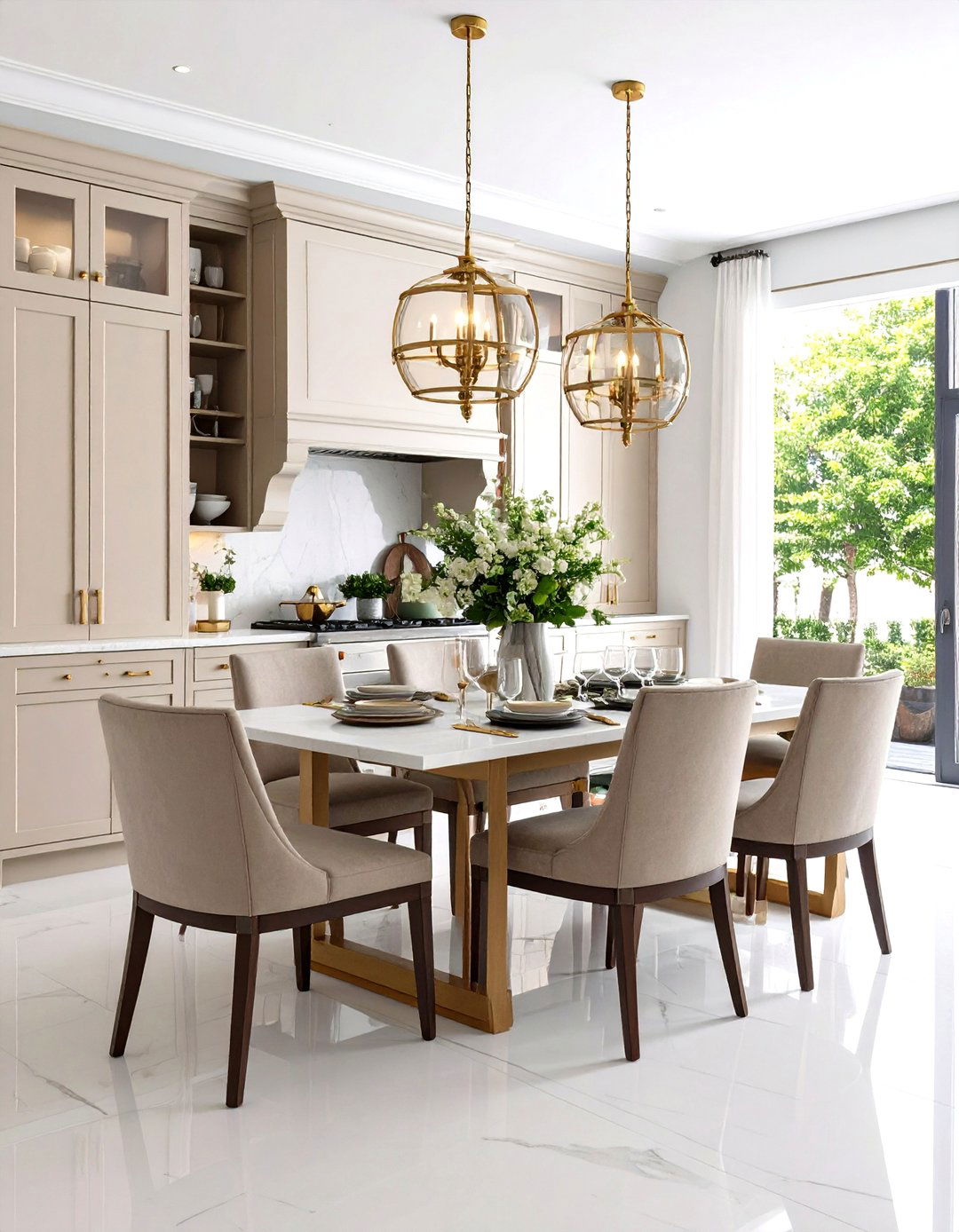
A statement begins when a wall-to-wall hutch spans your dining room like custom cabinetry, creating seamless unity with the architecture. Floor-to-ceiling units swallow seldom-used platters up high while everyday dishes stay at reachable eye level, eliminating the need for an extra sideboard. Fit the hutch with adjustable shelves, deep drawers for table linens, and concealed outlets for small appliances you’d rather hide. Paint the entire run in the same shade as the surrounding walls so the bulk recedes; then add contrasting brass pulls for sparkle. This built-in hutch quietly maximizes every inch, offering display and storage without visual clutter.
2. Farmhouse Distressed-Wood Hutch Charm
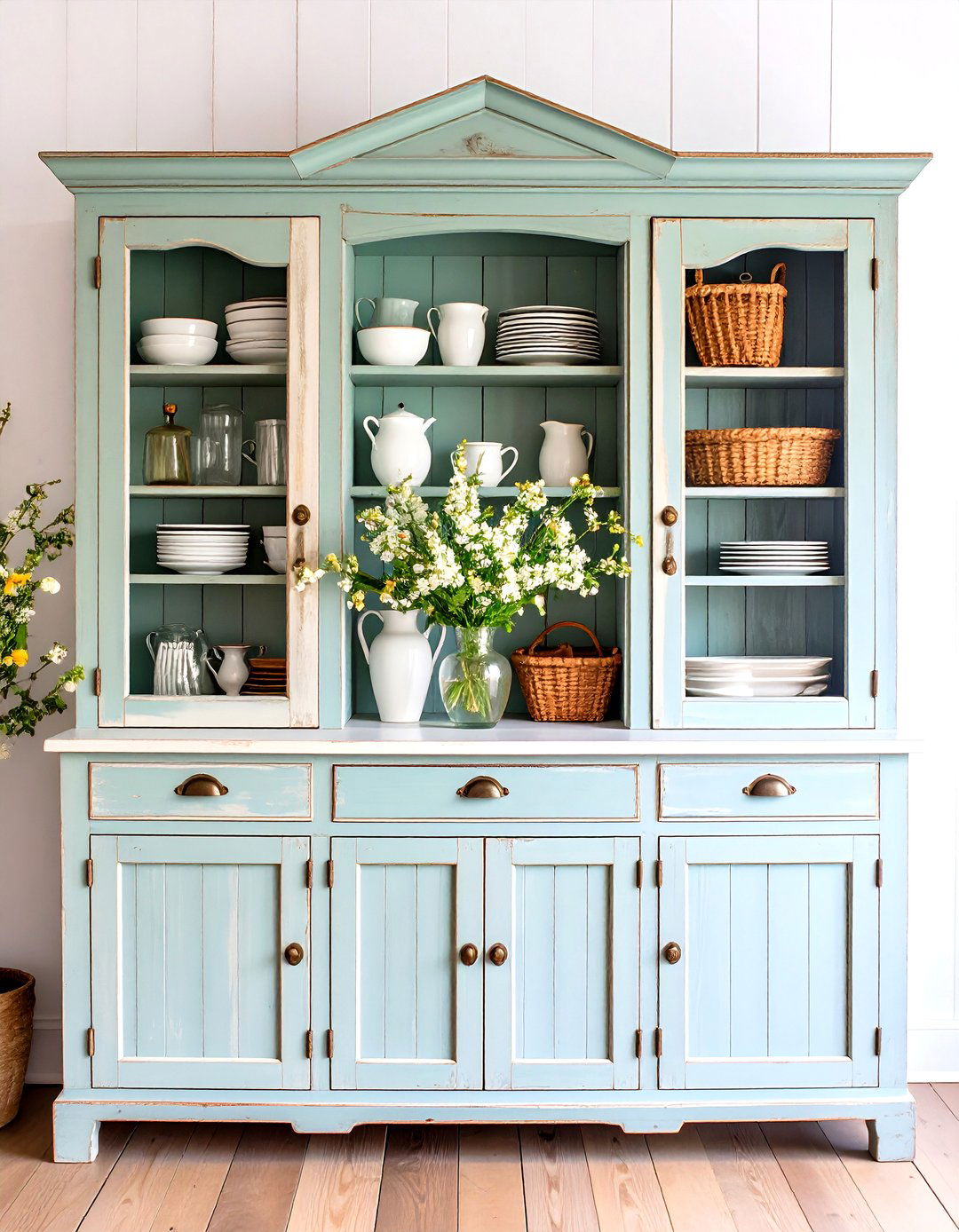
The endearing crackle of a farmhouse hutch never fails to warm a dining space. Start by hunting for a solid-pine or maple piece with paneled doors and classic crown molding; then bring it to life with a layered paint job — cream over slate, lightly sanded at corners for an authentically timeworn look. Swap dated hardware for cup pulls in oil-rubbed bronze, and line the shelves with gingham wallpaper for a subtle wink of pattern. Fill the hutch with ironstone pitchers, woven baskets, and stacks of white dinner plates so everyday items double as rustic décor and easy-grab essentials.
3. Modern Minimalist Floating Hutch

When floor area is tight, a floating hutch creates the illusion of space by revealing uninterrupted flooring beneath. Commission a slim, handle-less box in walnut veneer or color-matched MDF that hugs the wall just below eye level. Push-to-open doors hide clutter, while a 4-inch shadow gap between cabinet and ceiling keeps sightlines light. Beneath, install a recessed LED strip that washes the floor in ambient glow. The floating hutch stays visually calm yet works hard: tuck chargers in a rear cable grommet, store placemats in felt-lined drawers, and keep special glassware behind discreet smoked-glass panels.
4. Glass-Front Display Hutch With Lighting
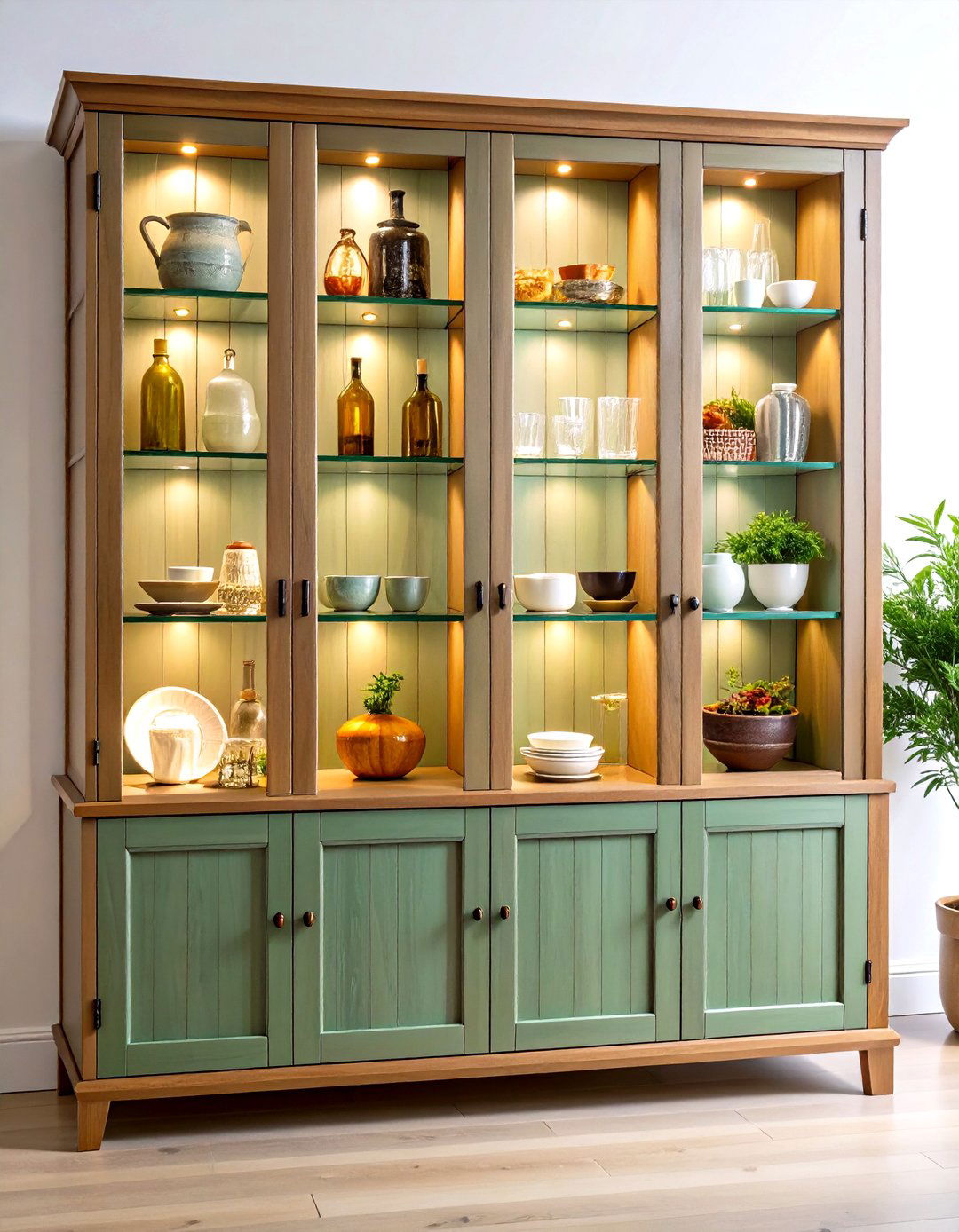
For collectors who love to see their treasures, a glass-front hutch becomes a display cabinet with purpose. Replace opaque doors with tempered glass and install dimmable LED puck lights on each shelf to highlight crystal, heirloom china, or artisanal ceramics. Paint the interior a soft contrasting hue — think sage against white frames — to let pale dishes pop. Adjustable glass shelves reflect light and keep the hutch airy, while a solid base cabinet hides less-attractive serve-ware. Remember to balance shiny pieces with matte textures like linen-wrapped boxes so the display feels curated, not cluttered.
5. Two-Tone Paint Hutch Makeover
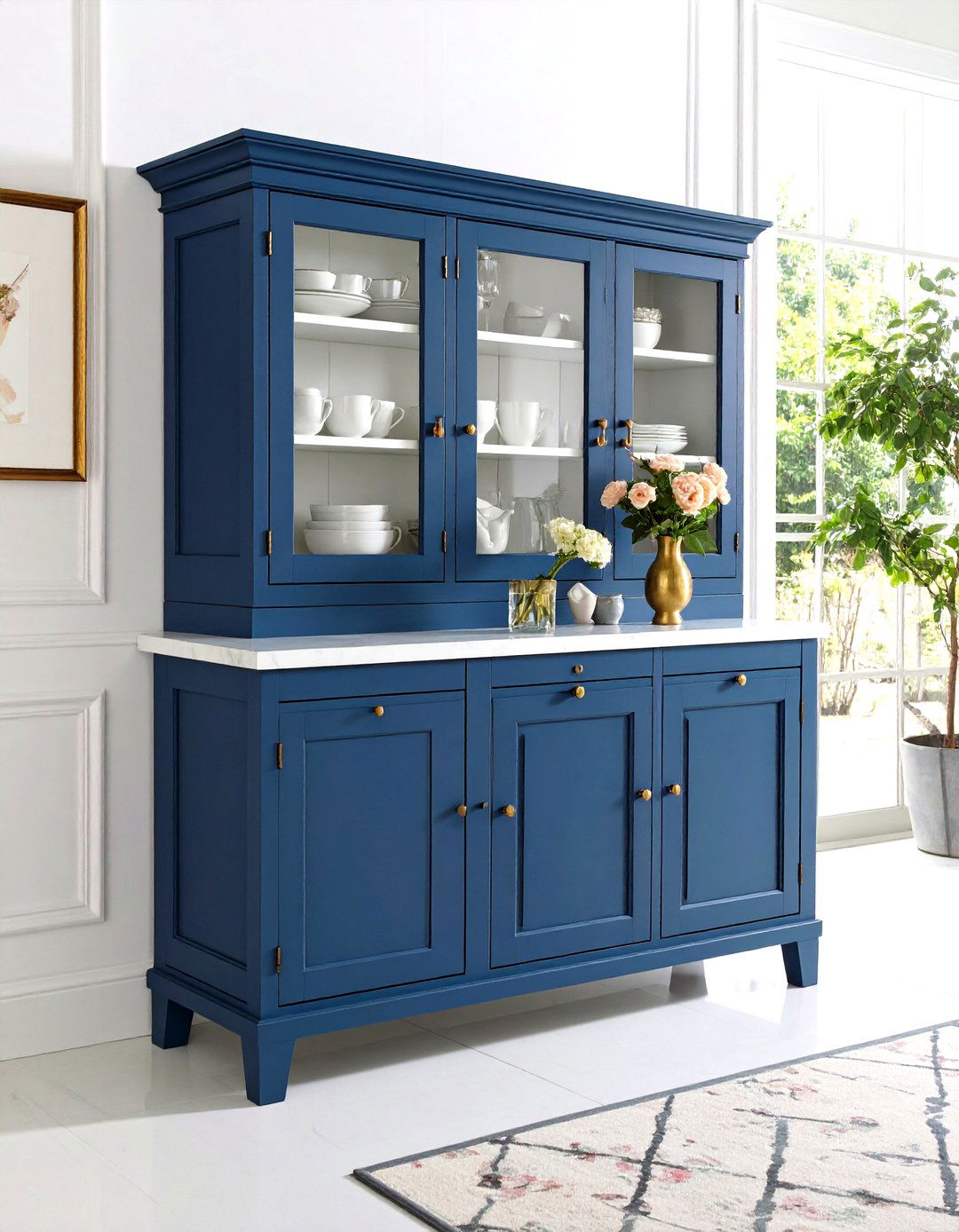
Take an ordinary thrift-store hutch from drab to dynamic with a two-tone palette. Paint the exterior in a rich, grounding color — navy, charcoal, or emerald — then coat the interior shelving in crisp white or a cheerful pastel. The contrast highlights whatever you store, acting like a built-in photo frame for dishware. If you’re nervous about bold color, apply it only to the base drawers, leaving the upper hutch neutral. Finish with updated knobs in brushed gold to lend cohesion. This makeover transforms a budget find into a designer-looking centerpiece without needing expensive carpentry.
6. Vintage French Provincial Hutch Revival
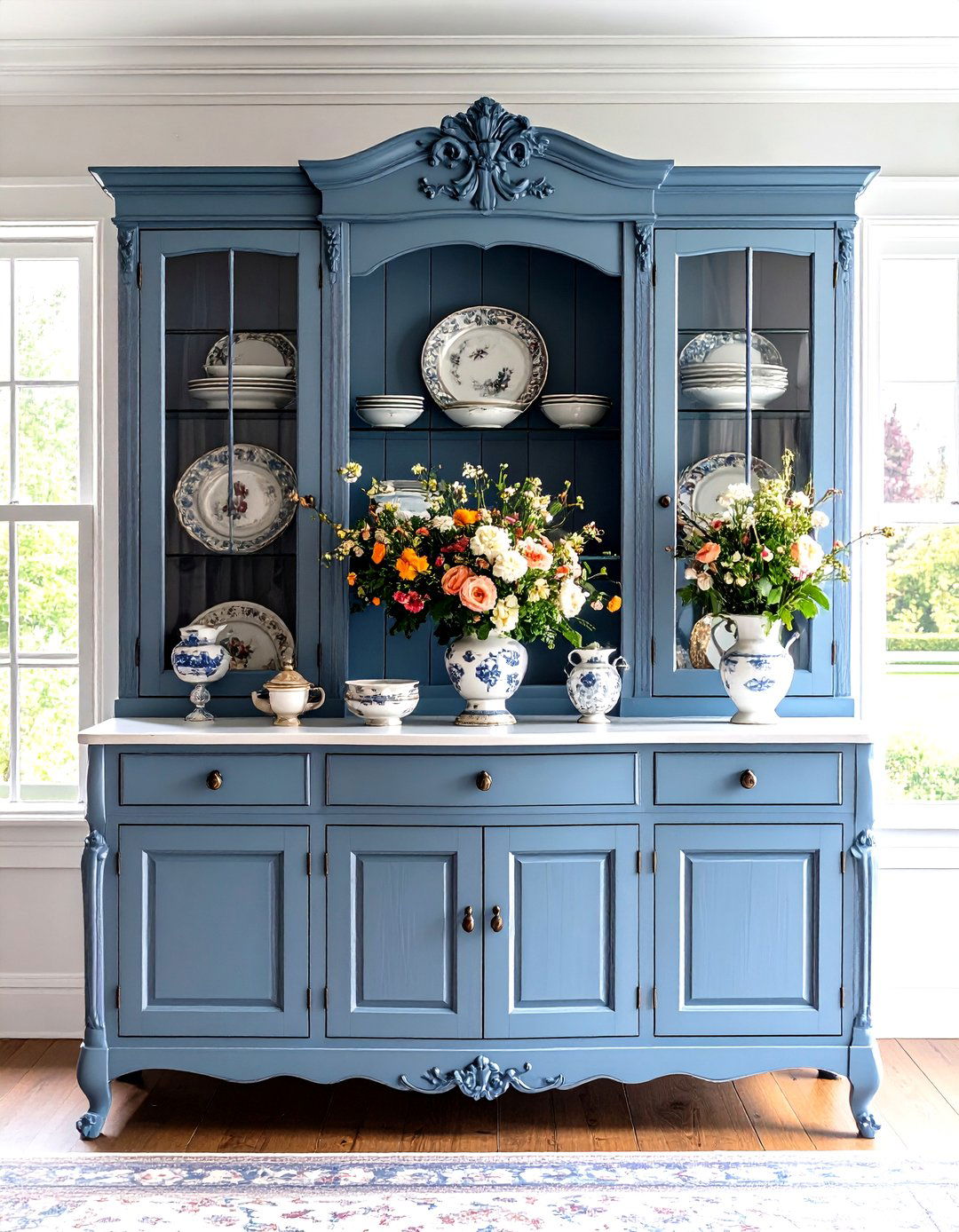
A curvy, French Provincial hutch immediately lends old-world charm to a dining room. Preserve ornate details by gently cleaning carved flourishes with a toothbrush and mild soap, then refresh the body with a chalk-paint layer in muted duck-egg blue. Highlight raised trim in antique white wax to accentuate depth. Inside, add glass shelves for lightness and line the back panel with toile fabric for a hint of Parisian cottage. Display silver platters upright with plate stands, letting their reflective surfaces bounce light around the hutch and echo the piece’s elegant curves.
7. Corner Hutch to Maximize Tight Spaces
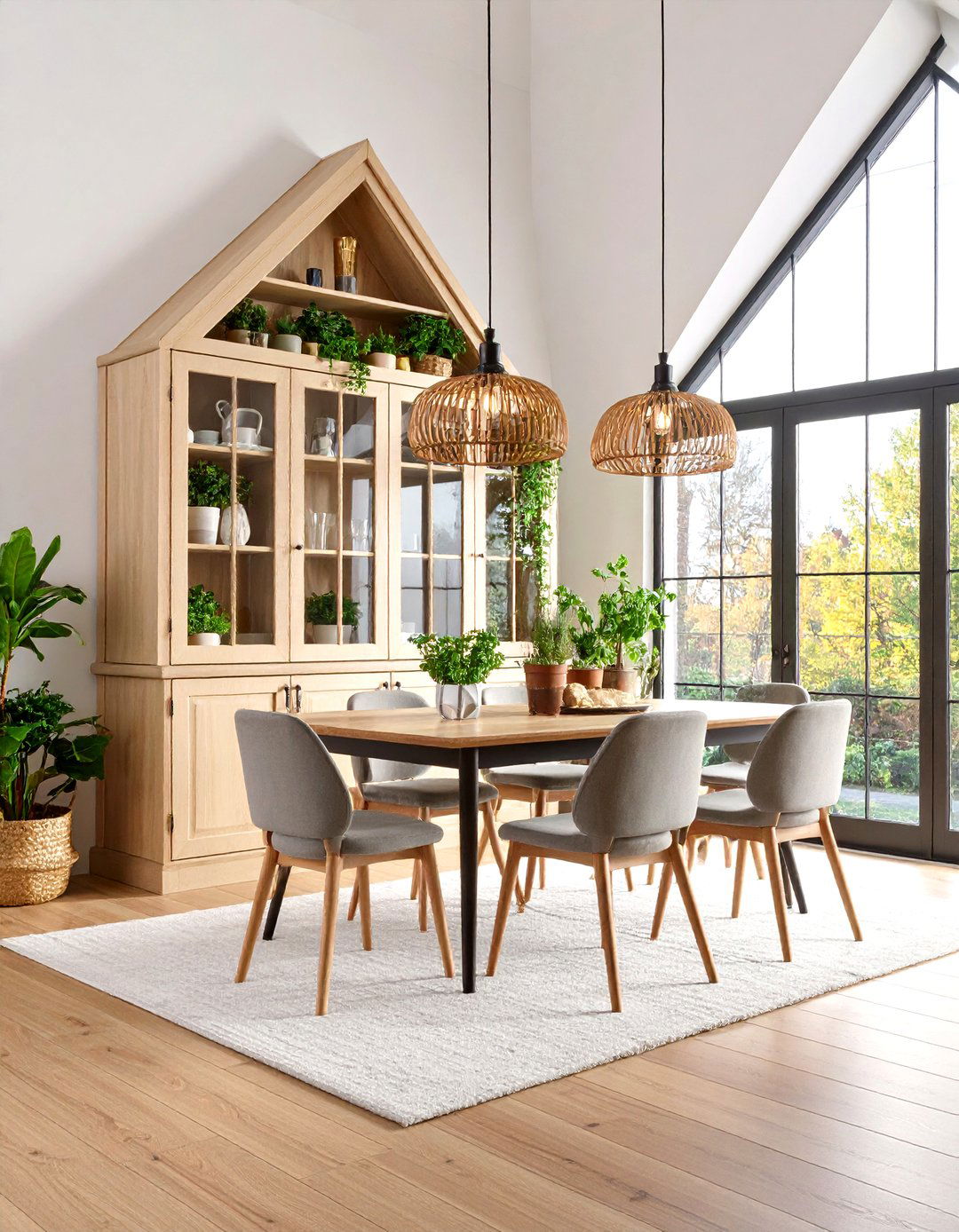
Those tricky corners in small dining rooms crave purposeful furniture, and a triangular-footprint corner hutch answers perfectly. Opt for one with tall, arched doors that draw the eye upward, visually stretching the space. Interior lazy-Susan shelves make awkward angles usable, while a small countertop section can host a potted herb or carafe. Paint the exterior to match adjacent walls so the hutch melts into its nook, then use glass doors on the upper portion to reflect light from nearby windows. Suddenly, a forgotten corner pulls weight as both storage and architectural interest.
8. Mirrored-Back Hutch for Depth and Shine
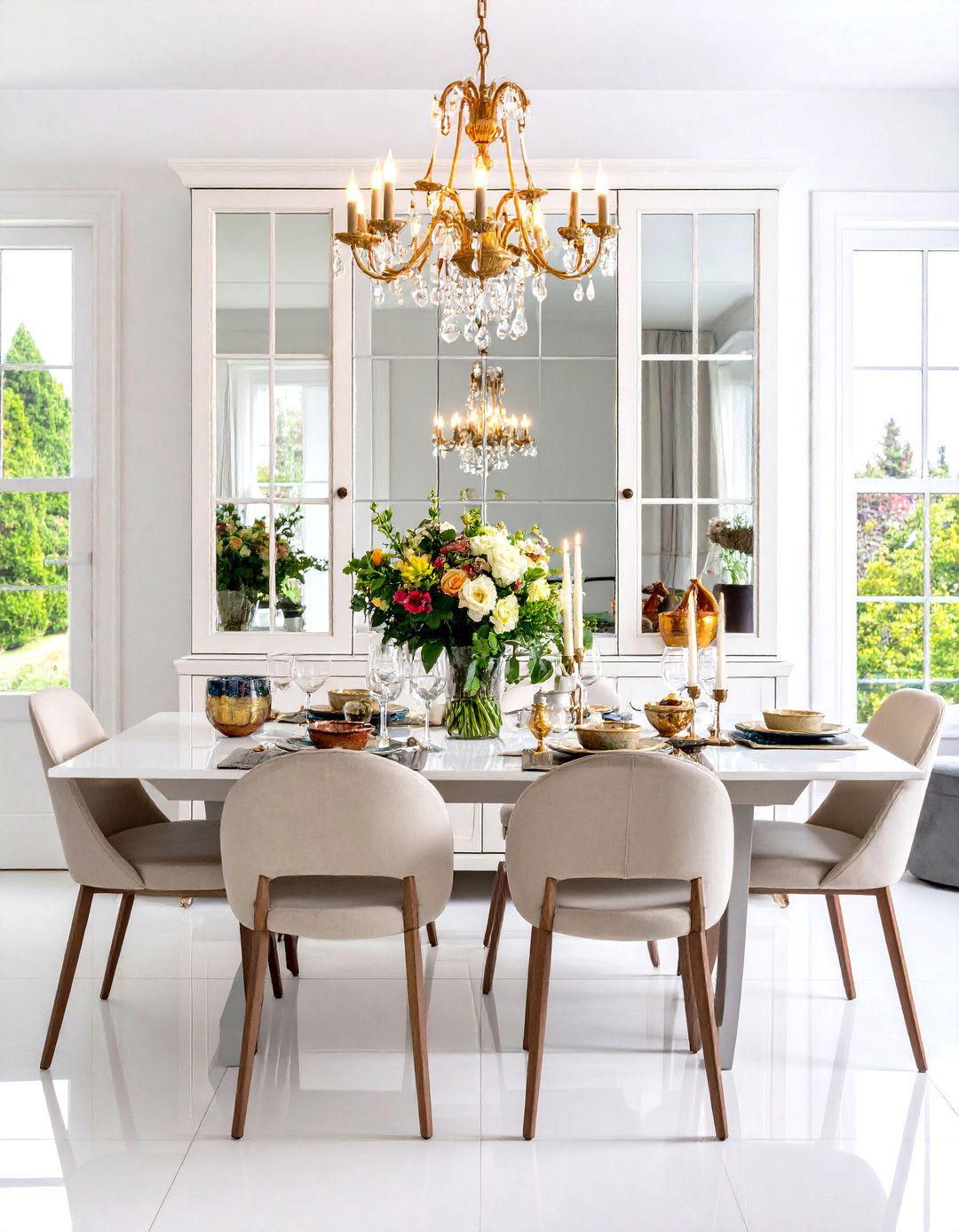
Because mirrors triple perceived depth, a mirrored-back hutch transforms even modest dish collections into gleaming vignettes. Remove the existing back panel and replace it with cut-to-size mirror, or apply peel-and-stick mirrored tiles for a renter-friendly option. The reflective surface multiplies candlelight during dinners and makes crystal glassware sparkle. Keep the remainder of the hutch simple — think plain white paint and minimal hardware — so the mirror remains the star. For daily practicality, store colorful serving bowls toward the bottom to ground the bright reflections and prevent a visual overload.
9. Hutch With Sliding Barn Doors
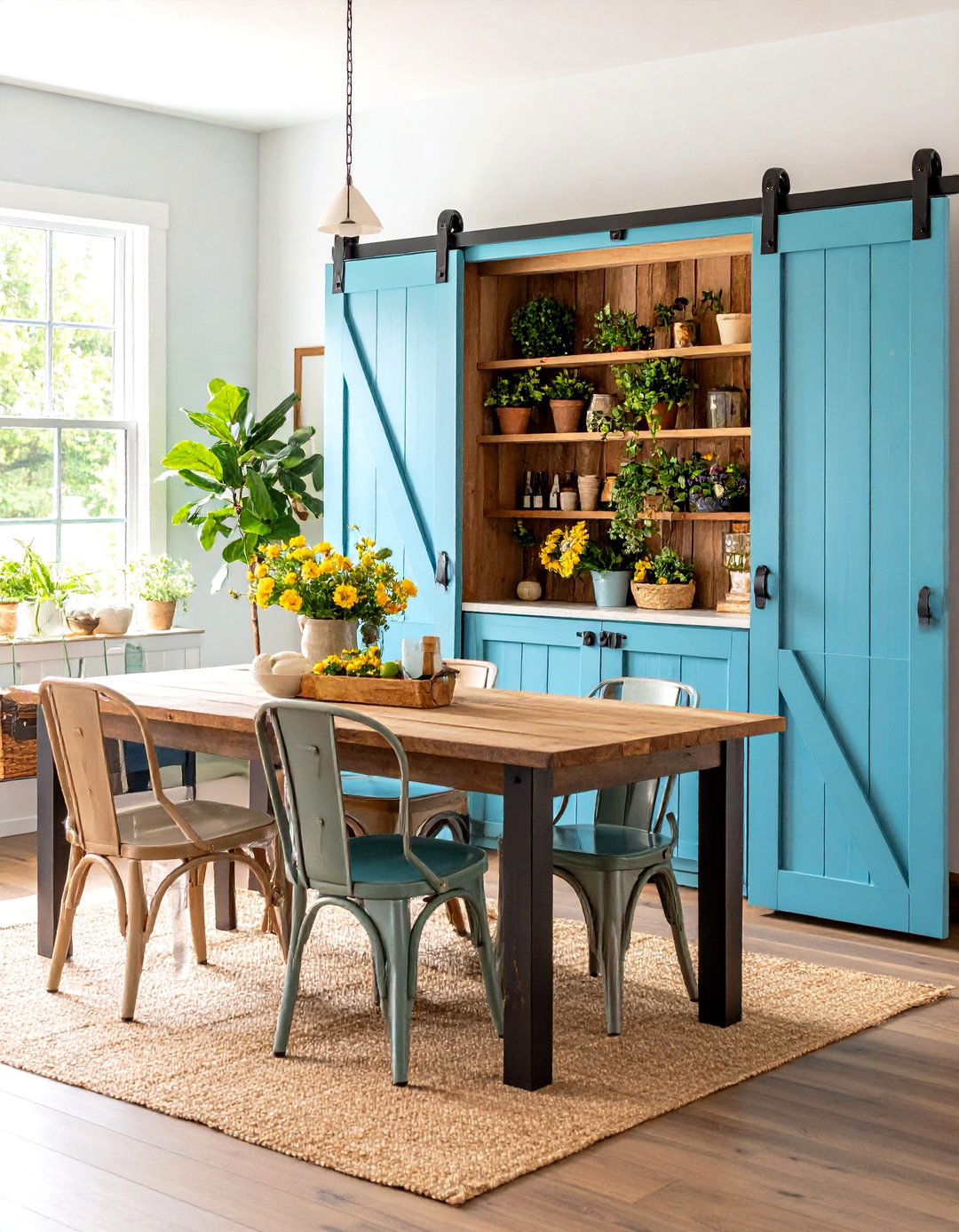
Sliding barn doors lend rustic flair while solving clearance issues in tight walkways. Mount a matte-black rail system across the hutch’s top and attach planked doors that slide smoothly to reveal one side at a time. Inside, organize items by frequency of use: everyday plates on the constantly exposed shelf, entertaining pieces behind the movable panel. Add hidden soft-close catches so doors don’t slam. This hutch design pairs perfectly with farmhouse tables or industrial pendant lights, bringing functional fun and a pinch of country attitude to an urban dining room.
10. Mid-Century Hutch With Tapered Legs
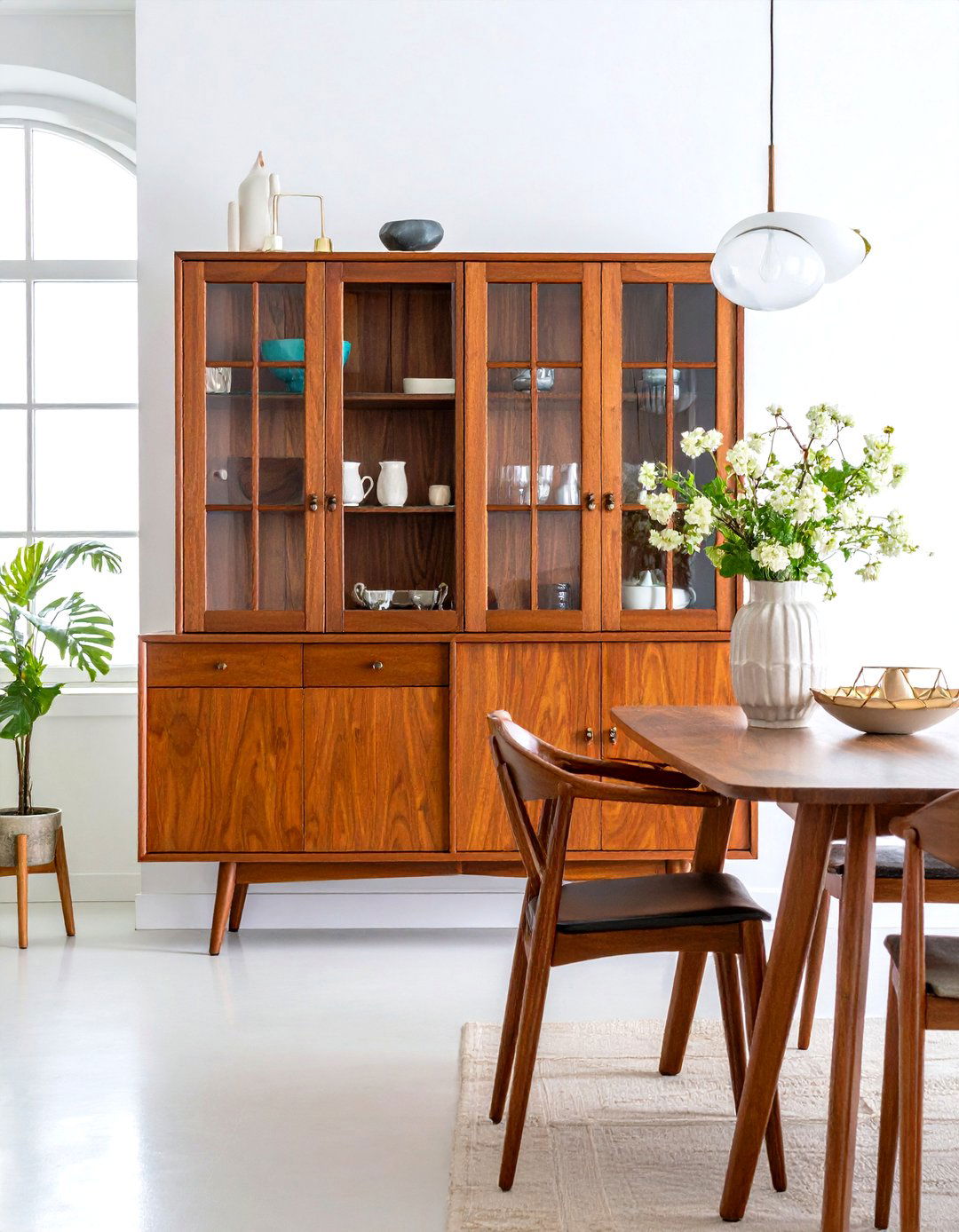
If you crave retro flair, look for a teak hutch sporting tapered legs and sleek finger-pull drawers. Restore the wood with Danish oil to revive its honeyed glow, and replace any ripped back panels with fresh walnut veneer. Inside the top cabinet, a single sculpted glass shelf showcases cocktail glasses, while below, wide drawers store linen napkins. Keep styling minimal — one ceramic vase, a geometric serving tray — so the hutch’s timeless lines stay front and center. The result is storage that nods to 1960s cool yet harmonizes with contemporary dining chairs.
11. Hutch Turned Coffee & Tea Bar
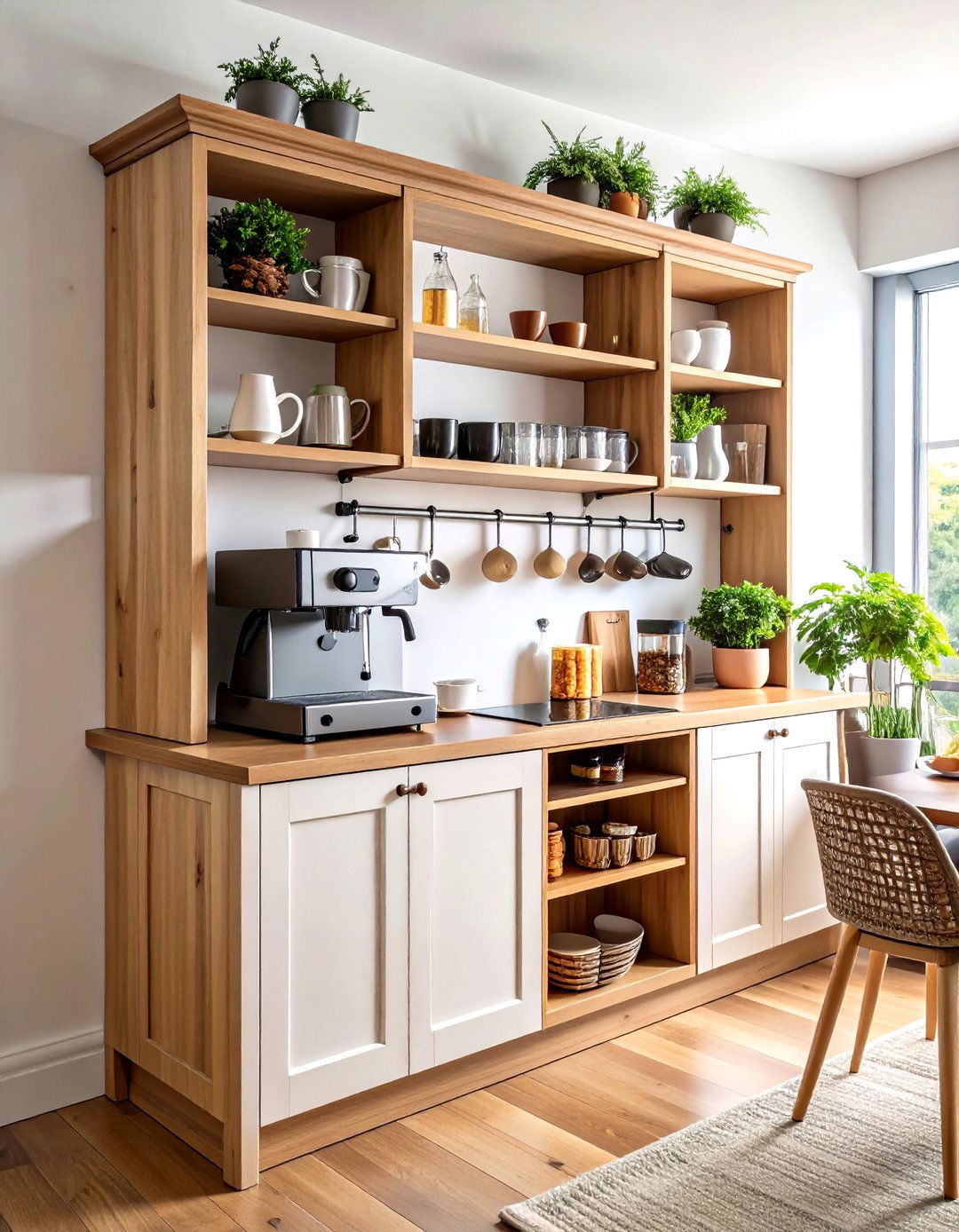
Turning a hutch into a beverage station keeps morning routines tidy and guests self-sufficient. Remove a center shelf to fit a drip machine or espresso maker, and drill a small hole at the back for cords. Stash mugs on hooks along the upper rail and line drawers with bamboo organizers for sweeteners or loose-leaf tea sachets. A chalkboard-paint panel inside a door can list favorite brews or steep times. Close everything behind doors when not in use, converting what might be countertop clutter into an organized, café-style nook inside your dining room.
12. Open-Shelf Hutch for Everyday Dishware
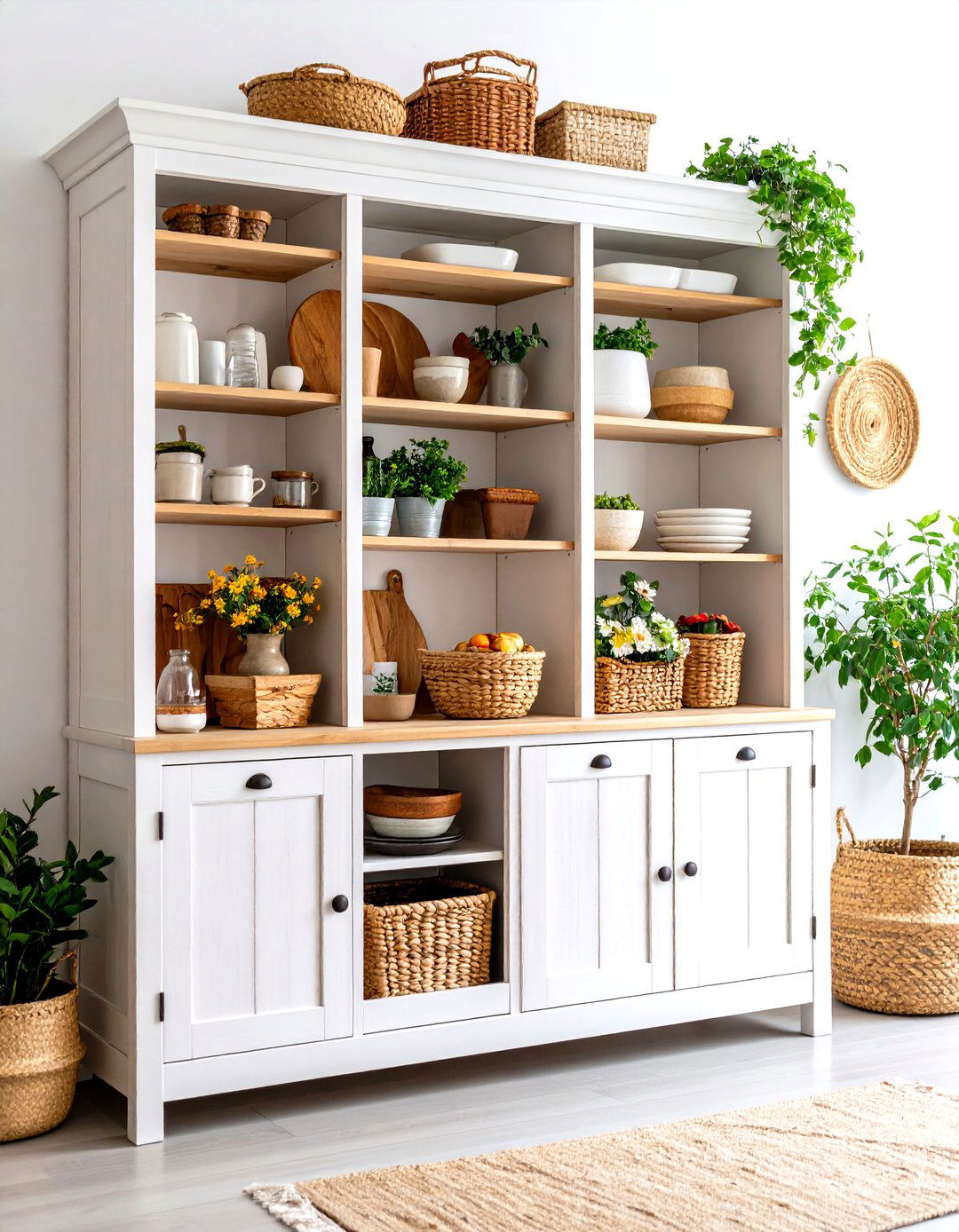
Sometimes doors are overrated; an open-shelf hutch encourages quick access and casual styling. Remove upper doors entirely and sand hinge marks flush, then finish the interior with a wipe-on polyurethane to protect against scratches. Stack neutral, mix-and-match stoneware in even piles, mixing in woven baskets for textural relief. Rotate seasonal décor — spring flowers, autumn gourds — onto the top shelf for easy refreshes. Because everything is visible, stick a small microfiber cloth on a command hook inside the base cabinet so you can give shelves a quick dust whenever you set the table.
13. Cane-Door Hutch for Airy Texture
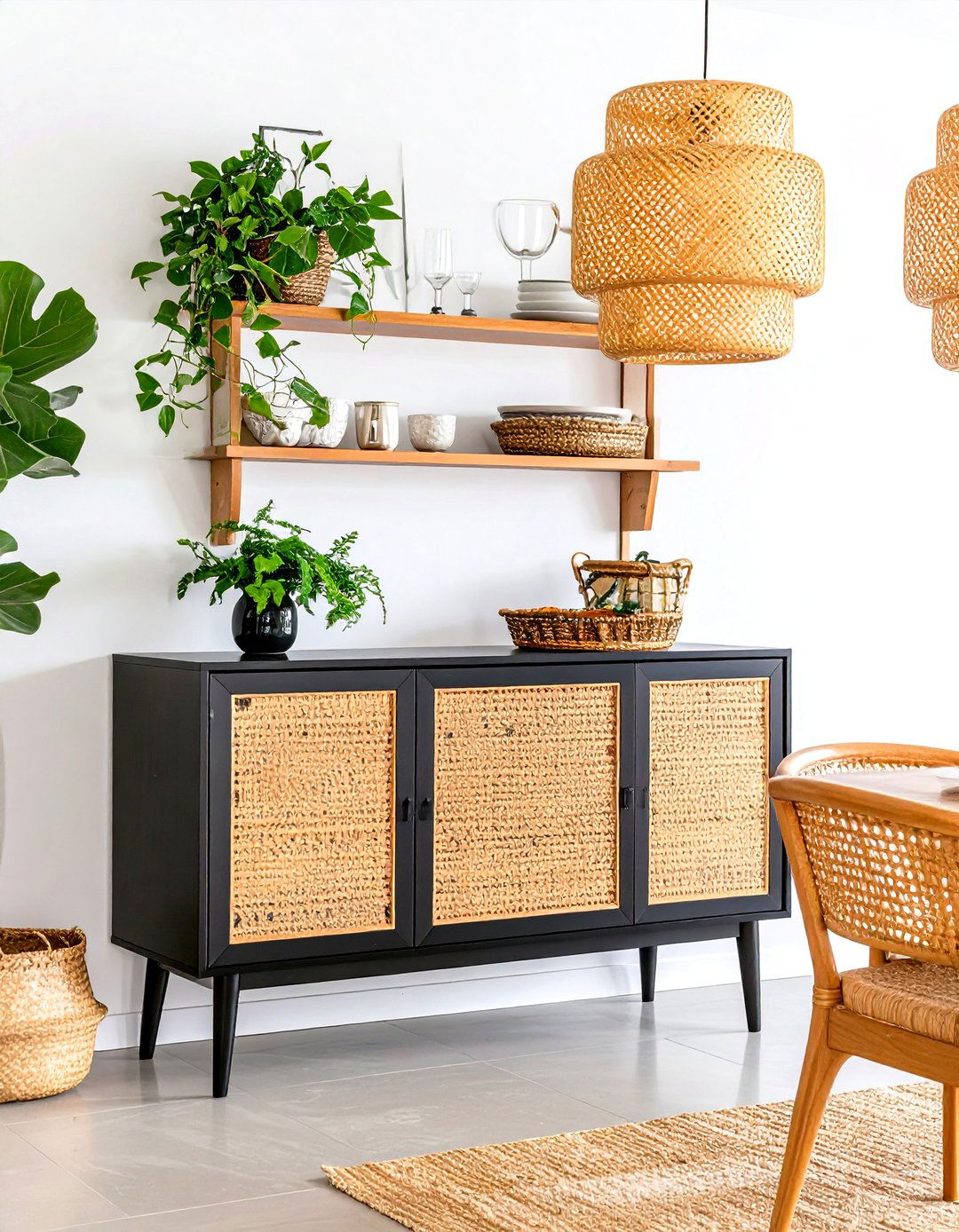
Cane-woven panels breathe lightness into a solid-wood hutch while nodding to tropical and mid-century vibes. Replace old inserts with pre-woven cane webbing attached using spline and wood glue. The semi-transparent weave hides minor mess but still hints at contents, keeping the hutch visually lighter than solid doors. Finish the frame in warm satin-black paint to contrast with the honey-toned cane. Inside, stick to monochrome dishware so patterns don’t compete with the lattice. Add under-shelf puck lights to cast playful shadows through the cane for evening ambiance.
14. Bold Color Statement Hutch
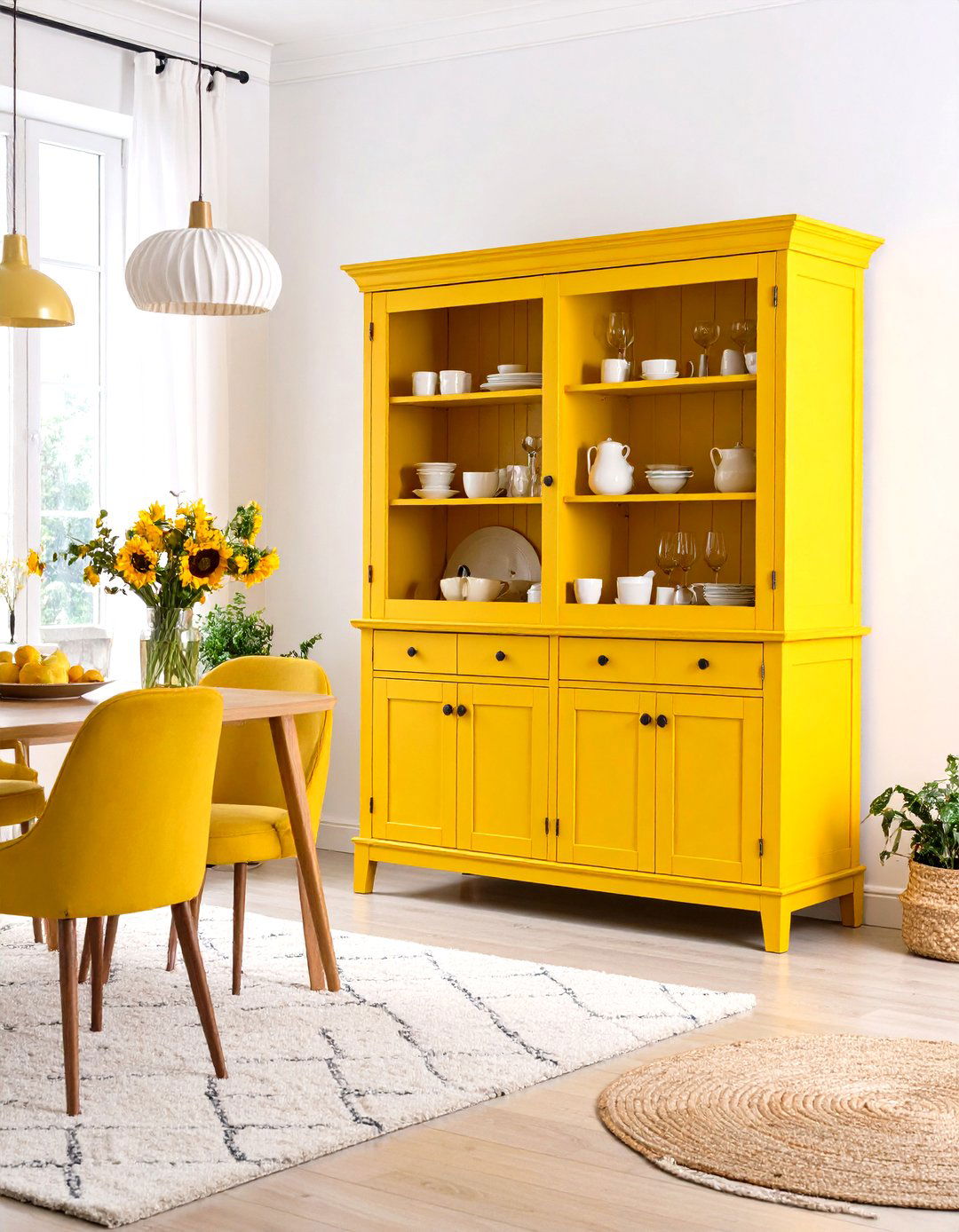
A fearless dash of color can turn a plain hutch into an instant focal point. Choose a vibrant hue — sunflower yellow, terracotta, or cobalt — and paint both exterior and interior for full impact. Balance the intensity by displaying mostly white or clear dishes, letting negative space calm the palette. A matte or eggshell finish feels modern, but rub wax on edges afterward if you’d like subtle distressing. To tie the look into the room, echo the hutch color in a patterned rug or artwork, ensuring the bold piece feels planned rather than random.
15. Hutch With Pull-Out Drawers for Linens
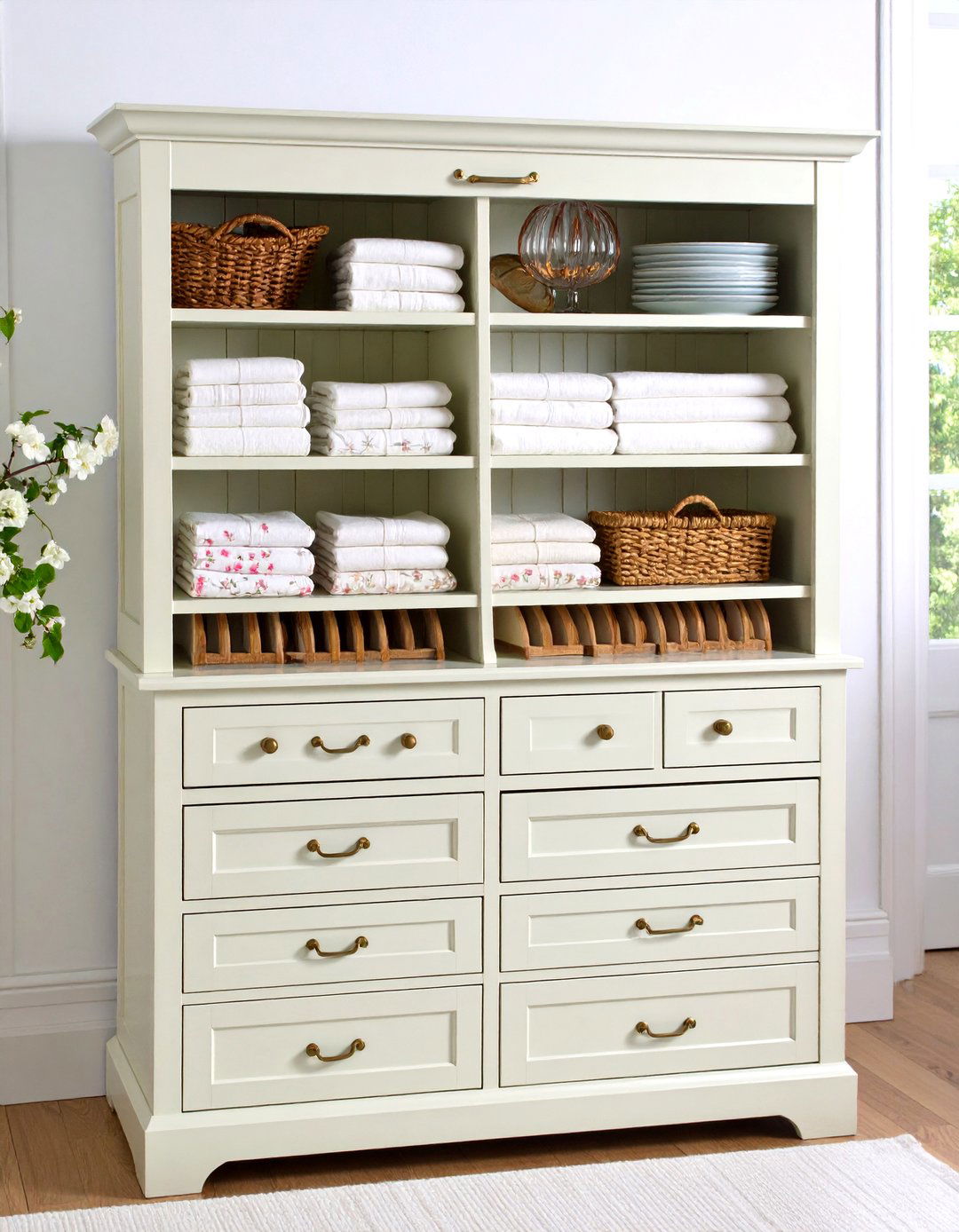
Deep base cabinets often become jumbled black holes; installing pull-out drawers keeps tablecloths and runners pristine. Measure interior width, then retrofit full-extension birch trays on ball-bearing slides so you can see every fabric at once. Label drawer fronts with tiny brass tags — “napkins, ” “placemats, ” “candles” — so family finds hosting supplies fast. Above, reserve shelves for chargers and folded cloth napkins stacked upright like files. Because linens breathe better in wood than plastic, your hutch becomes a soft-storage hero, prolonging the life of textiles and streamlining pre-dinner setup.
16. Reclaimed-Wood Rustic Hutch

For eco-minded decorators, a reclaimed-wood hutch tells a story through knots, nail holes, and color variations. Source boards from pallets, barns, or salvage yards and work with a carpenter to craft a sturdy carcass with simple shaker doors. Seal the wood with clear, food-safe wax to showcase grain while preventing splinters. Pair the rugged hutch with sleek chairs or metallic light fixtures to keep the look elevated, not overly country. Inside, group white ironstone and glass jars, allowing the weathered timber backdrop to provide its own rich, natural artwork.
17. Minimalist Scandinavian Hutch
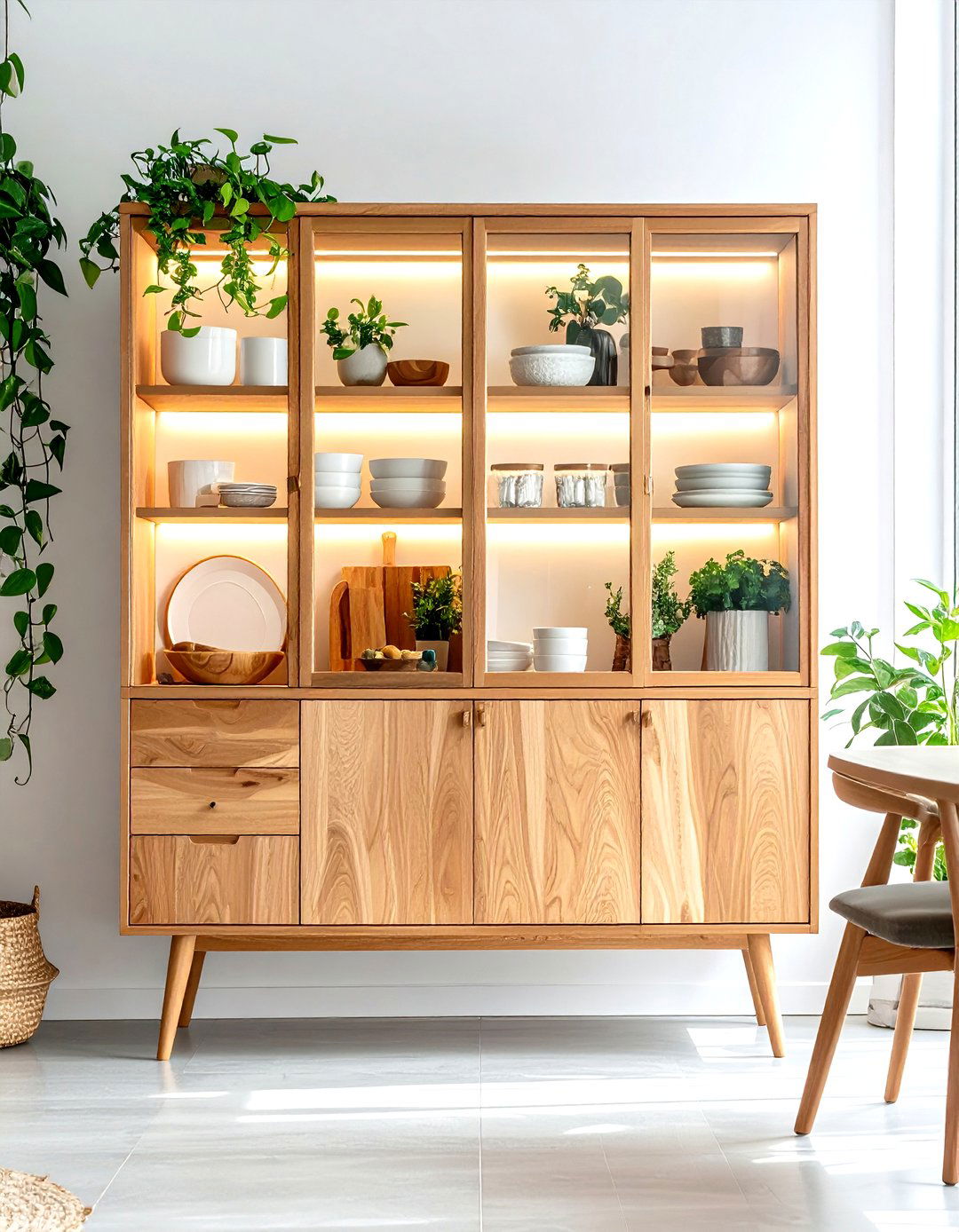
Scandi style revolves around light, order, and natural texture — perfect qualities for a dining hutch. Choose a pale-oak veneer cabinet on slender legs so light can flow underneath. Replace solid panels with reeded glass, which blurs contents yet diffuses light softly. Keep interior styling strict: stacks of white porcelain, blonde-wood salad bowls, and one trailing pothos plant for life. A motion-sensing LED strip activates when you open the hutch, useful during dark winter mornings. This minimal approach honors the Scandinavian mantra that beauty and utility should be inseparable.
18. Hutch With Chalk-Paint Artistic Finish
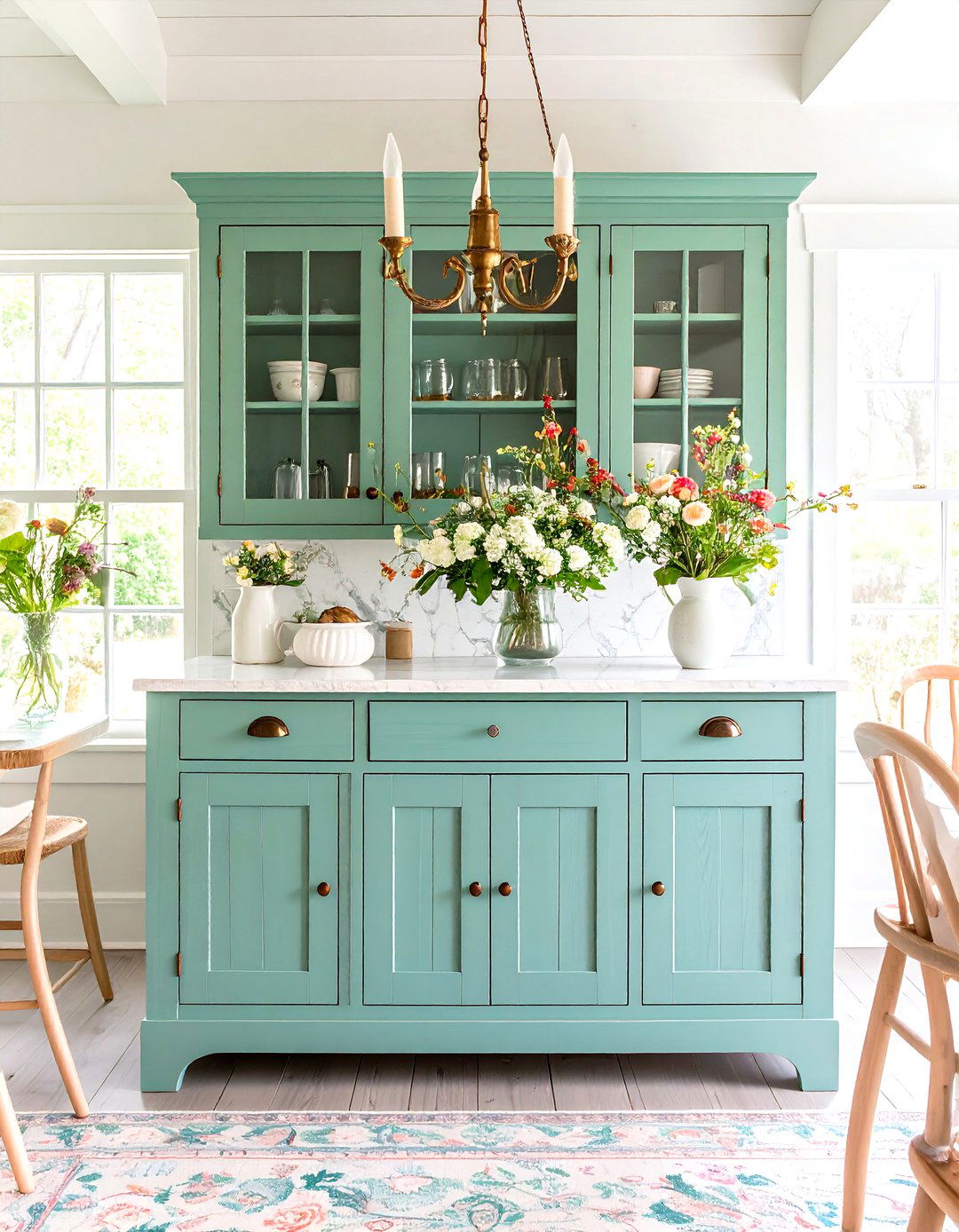
Chalk paint offers a forgiving, brushstroke-embracing finish that transforms a tired hutch in a single weekend. Clean thoroughly, skip heavy sanding, and apply two coats of your chosen shade — sage, blush, or storm gray. Before sealing, distress lightly along corners with fine grit paper for a lived-in effect. Finish with clear wax for protection or dark wax to age it. The matte texture invites tactile engagement, while a contrasting stencil along the hutch’s kick plate adds a folk-art twist. Inside, line shelves with peel-and-stick marble paper to elevate the casual paint job.
19. Hutch as Pantry Extension
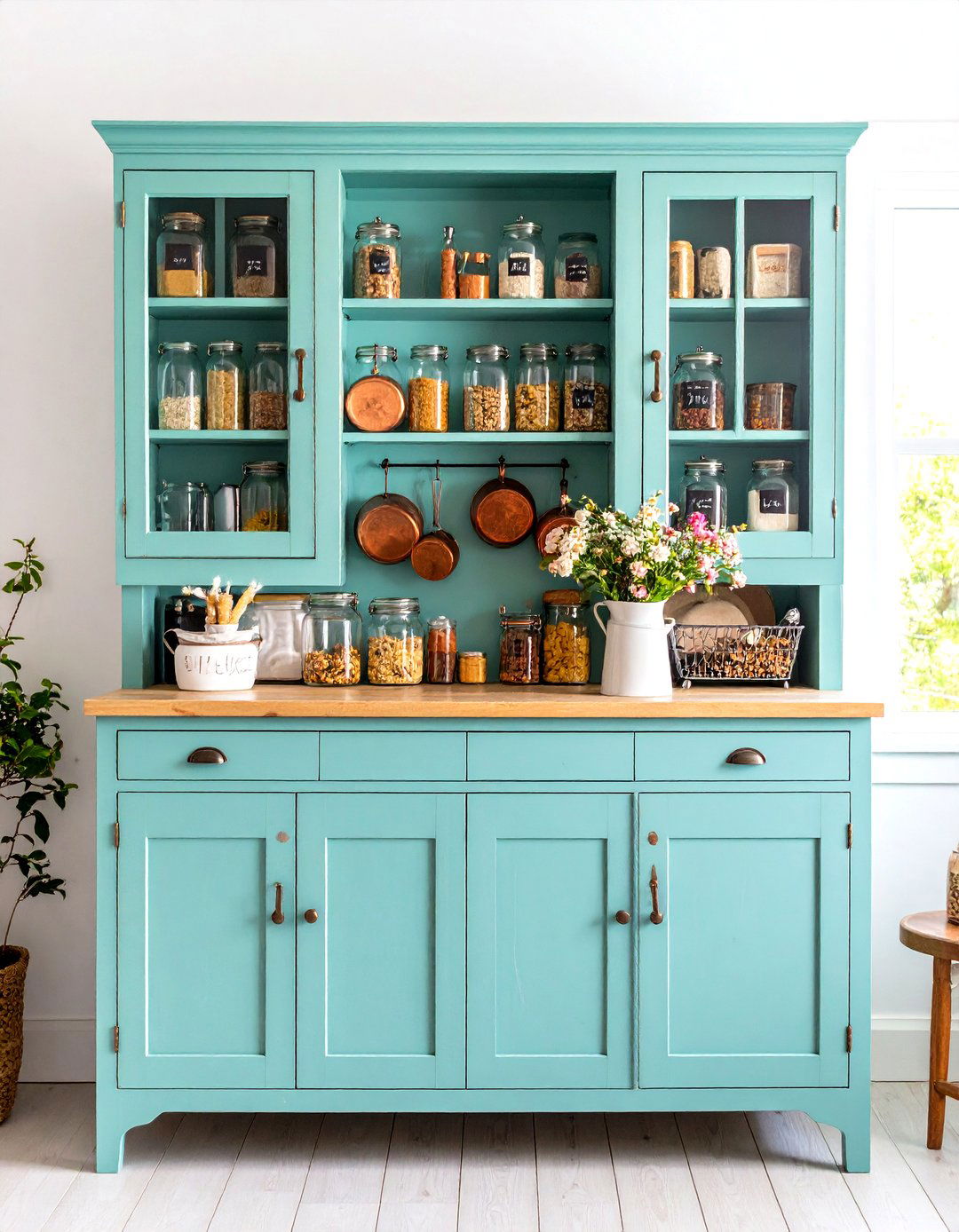
When kitchen cabinets overflow, a dining-room hutch can moonlight as a stylish pantry. Outfit interior shelves with matching glass canisters for dry goods, attaching chalkboard labels for clarity. Install a tension rod across one shelf to hang lightweight copper pots or measuring spoons. Use pull-out wire baskets on lower levels to corral snacks and baking supplies. Keep doors opaque to hide utilitarian contents, but paint them the same color as adjoining trim work so the “pantry” blends in. Dinner guests will never guess pantry staples sit just inches away.
20. Mirrored-Glass Hutch for Glam Dining
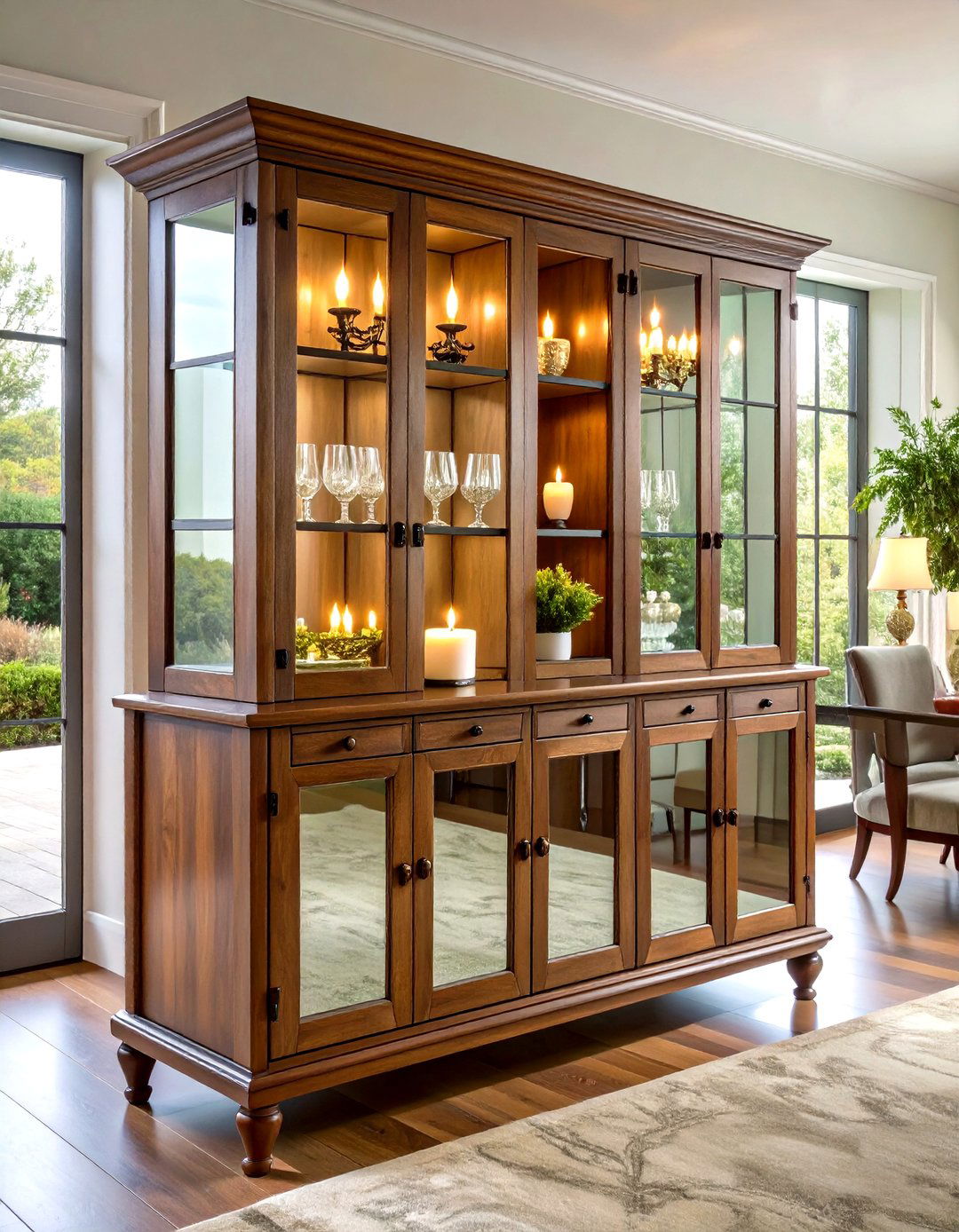
Combine luxury and utility by cladding your hutch in antiqued mirror panels. Start with a simple frame, then adhere custom-cut mirror pieces to door fronts and side panels, leaving slim wood borders for definition. The smoky reflections amplify candlelight and make the dining area feel twice as wide. Line the interior with velvet-backed shelves that cradle delicate stemware, adding a posh retail-boutique vibe. Keep surrounding décor understated — neutral paint, streamlined chairs — so the mirrored hutch commands undivided attention without tipping into excess.
21. Hutch With Curved Glass Doors
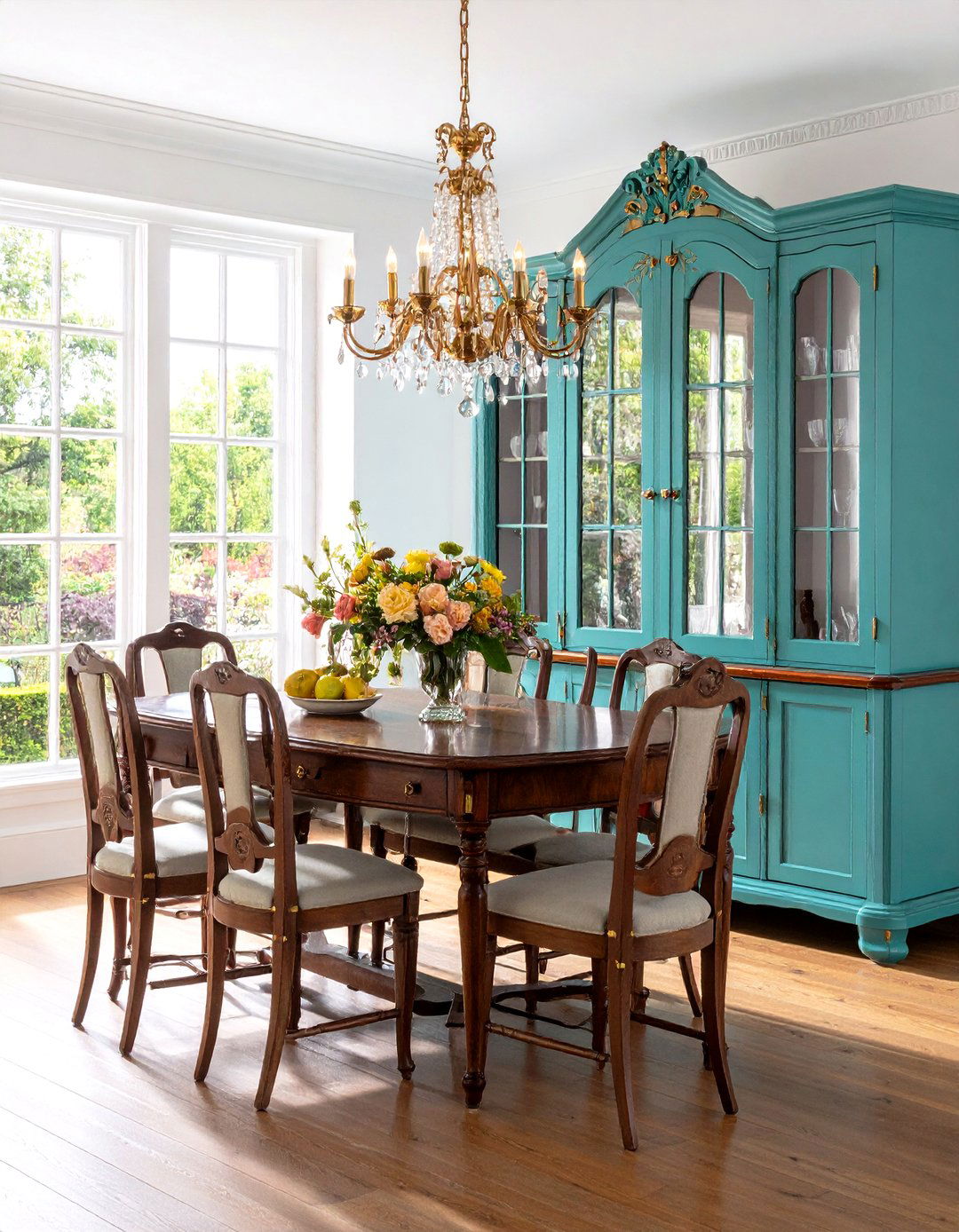
Curved-glass doors lend museum-quality elegance and soften the boxy lines typical of hutches. Search estate sales for broken china cabinets, salvage the bowed glass, and retrofit it into a fresh frame. Install hidden European hinges to maintain the uninterrupted curve. Inside, mirror the back panel to create a jewel-box effect, then remind yourself to dust regularly — curved glass catches light beautifully but reveals smudges quickly. This graceful hutch suits traditional dining rooms or transitional spaces needing a statement piece that blends history with craftsmanship.
22. Lighted LED-Strip Hutch Highlight
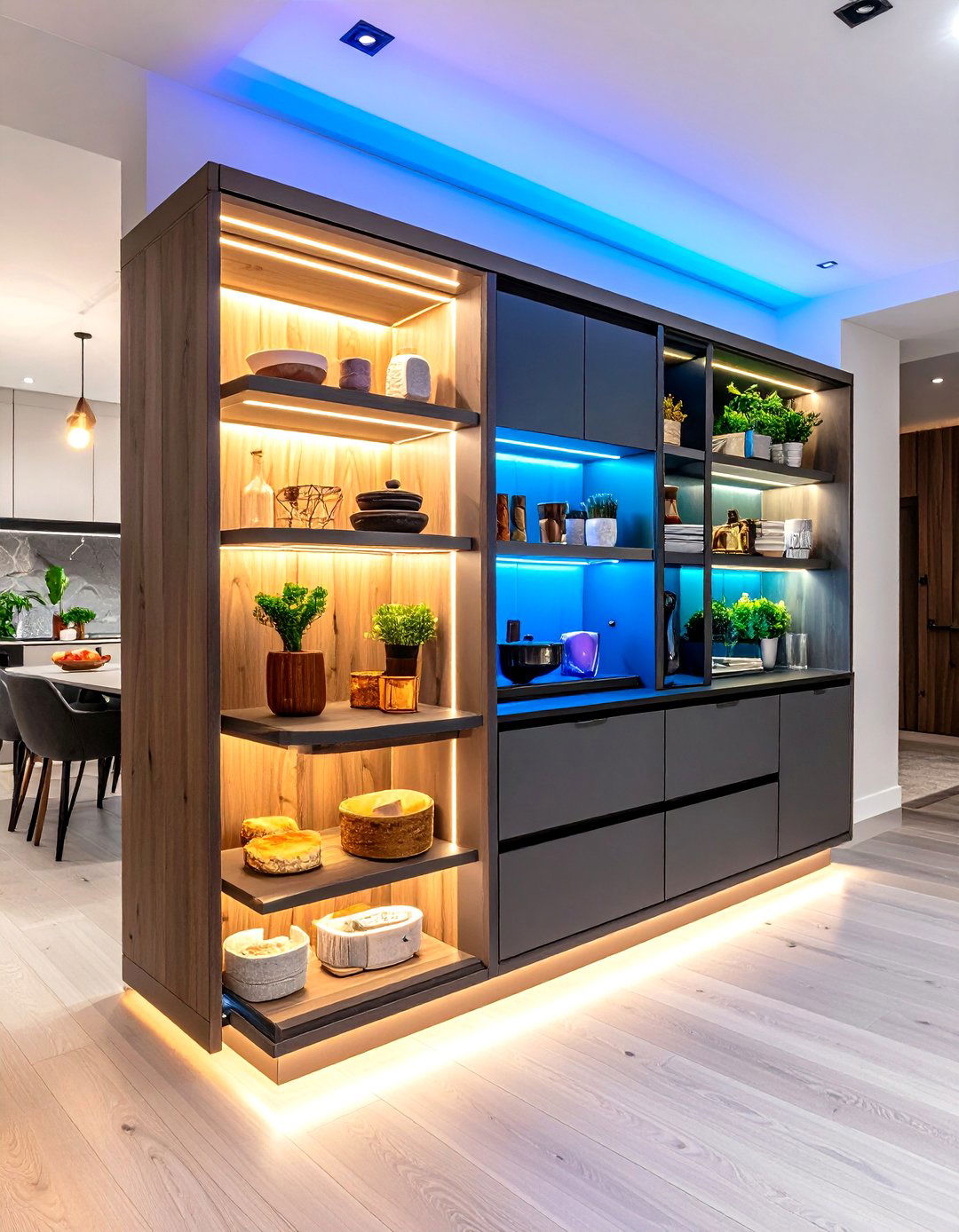
Task lighting isn’t just for kitchens; adding an LED-strip system turns a hutch into a glowing showcase. Affix adhesive strips beneath each shelf edge, connect them to a smart switch, and fine-tune brightness via phone. Warm-white LEDs flatter wood tones and dinnerware alike, while color-changing options let you shift ambience for holidays or late-night snacks. Hide cords in stick-on raceways along cabinet backs. The illuminated hutch doubles as indirect dining-room lighting, reducing reliance on overhead fixtures and sprinkling welcoming radiance across evening gatherings.
23. Modular Stackable Hutch System
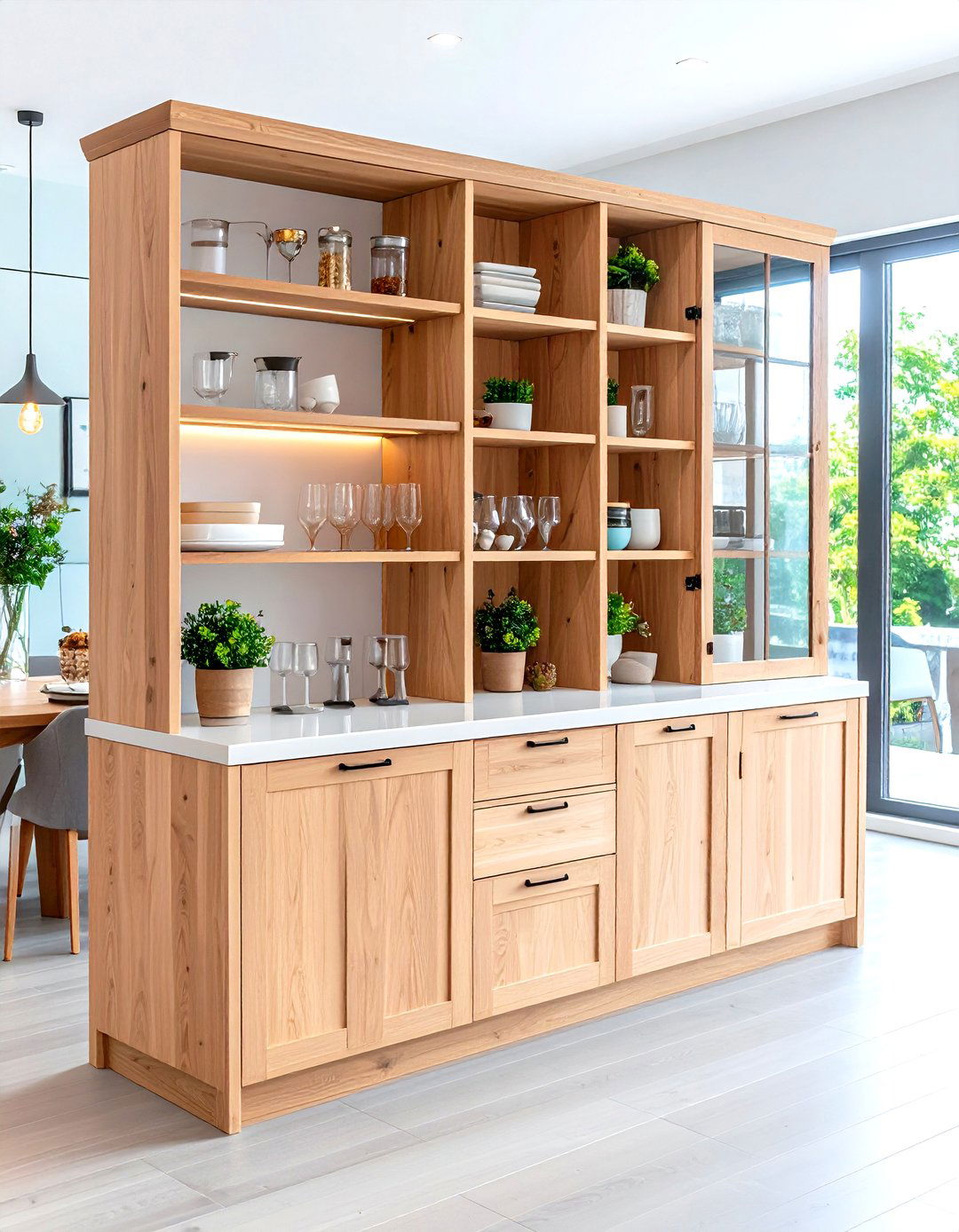
Renters or frequent movers appreciate furniture that adapts, and a modular hutch system answers that need. Purchase separate base cabinets, shelf cubes, and glass-door uppers that latch together with concealed connectors. Reconfigure pieces vertically in a compact apartment or horizontally in a spacious home; you can even split the set, using part as a living-room console later. Choose neutral finishes — white oak, matte ivory — so additions remain cohesive over time. Because each module is manageable, you can carry them through tight stairwells without hiring bulky-item movers.
24. Hutch With Art Display Shelves
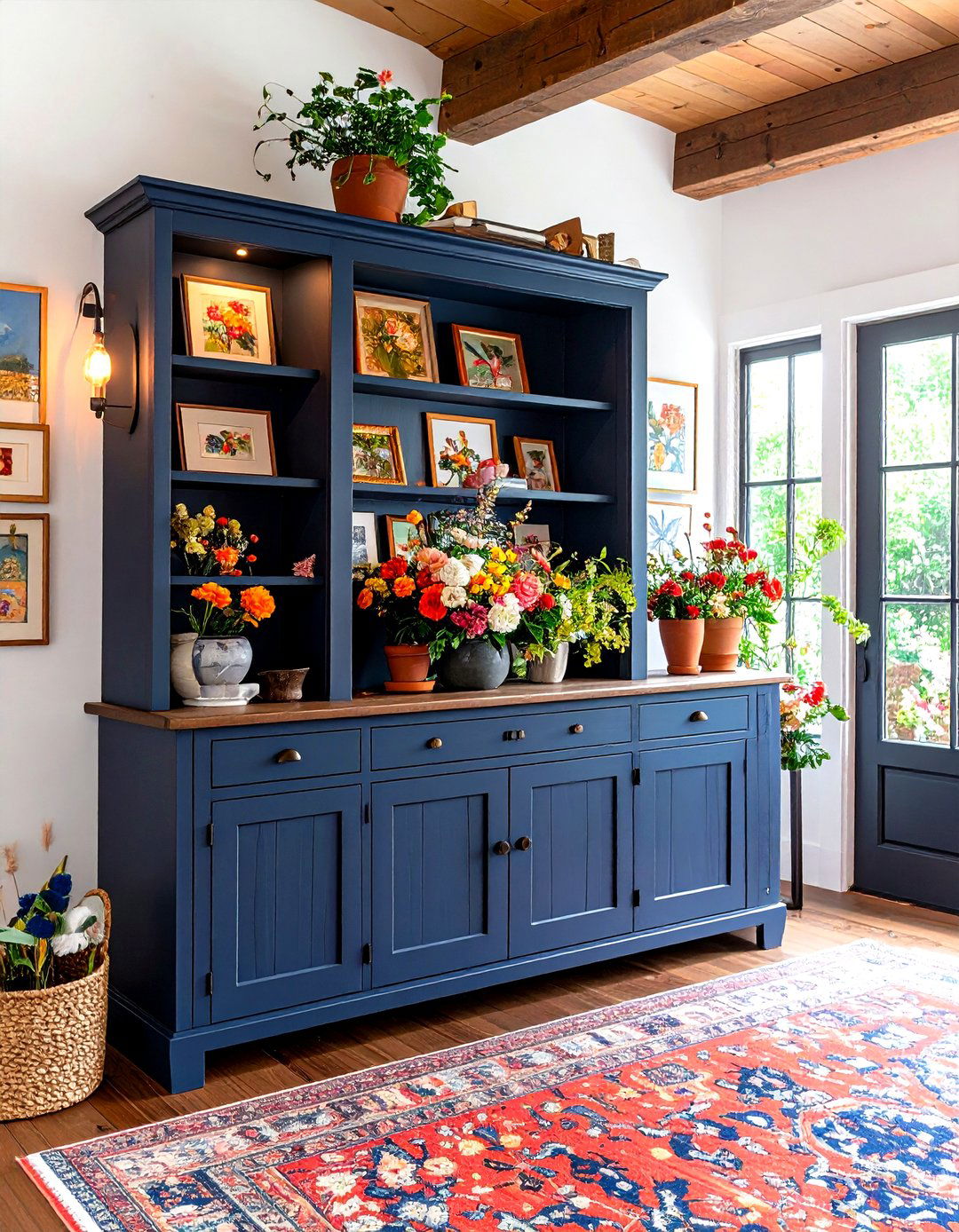
If your dish collection is small, repurpose a hutch into a micro-gallery. Remove two shelves and replace them with picture-ledges set at slight angles to cradle framed art. Paint the hutch interior a deep charcoal to make colors pop, then spotlight each ledge with miniature, battery-powered art lights. Store table linens in the base and rotate artwork seasonally — watercolors in spring, abstract prints in winter. By merging storage and exhibition, this art-centric hutch keeps the dining room personal and ever-evolving without sacrificing utility.
25. Sustainable Bamboo Hutch
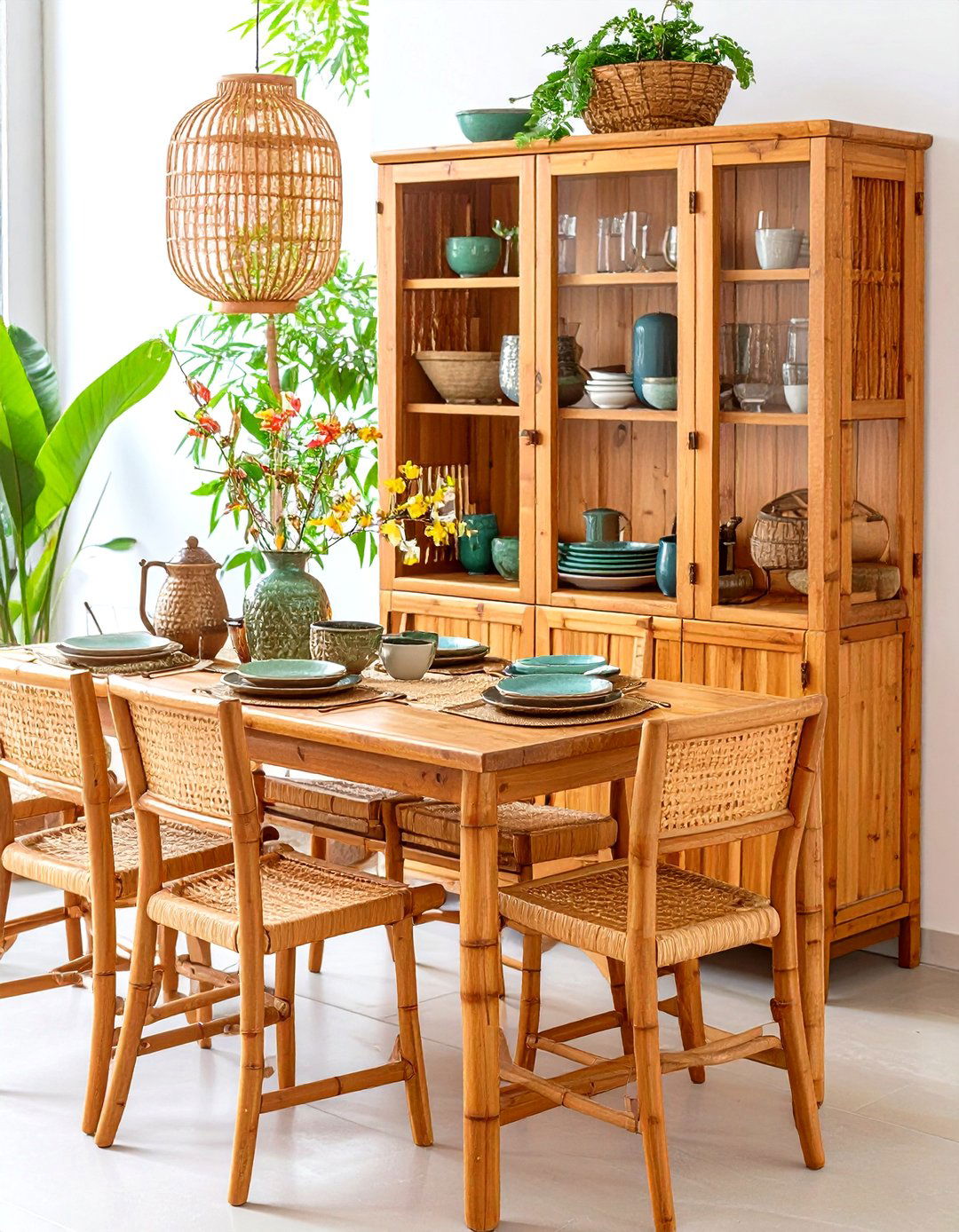
Eco-friendly and refreshingly modern, a bamboo-ply hutch delivers strength, subtle grain, and quick-renewable origins. Opt for version finished in low-VOC water-based lacquer to maintain indoor air quality. Because bamboo’s fine lines read visually clean, pair the hutch with textured dinnerware — stoneware, hammered metal — to add dimension. Interior adjustable shelves adapt to changing storage needs, while integrated finger grooves eliminate additional hardware and keep the look minimalist. A bamboo hutch not only stores your essentials but also signals commitment to sustainable living, rounding out our list with future-minded flair.
Conclusion:
Every hutch on this list shows how thoughtful tweaks turn simple storage into a star, whether you crave farmhouse coziness, minimalist calm, or eco-conscious innovation. Choose the idea that resonates with your habits, measure your space carefully, and let function guide styling decisions. A well-planned dining-room hutch streamlines hosting, protects cherished pieces, and anchors décor with personality — proof that one versatile cabinet can make everyday meals feel a touch more extraordinary.


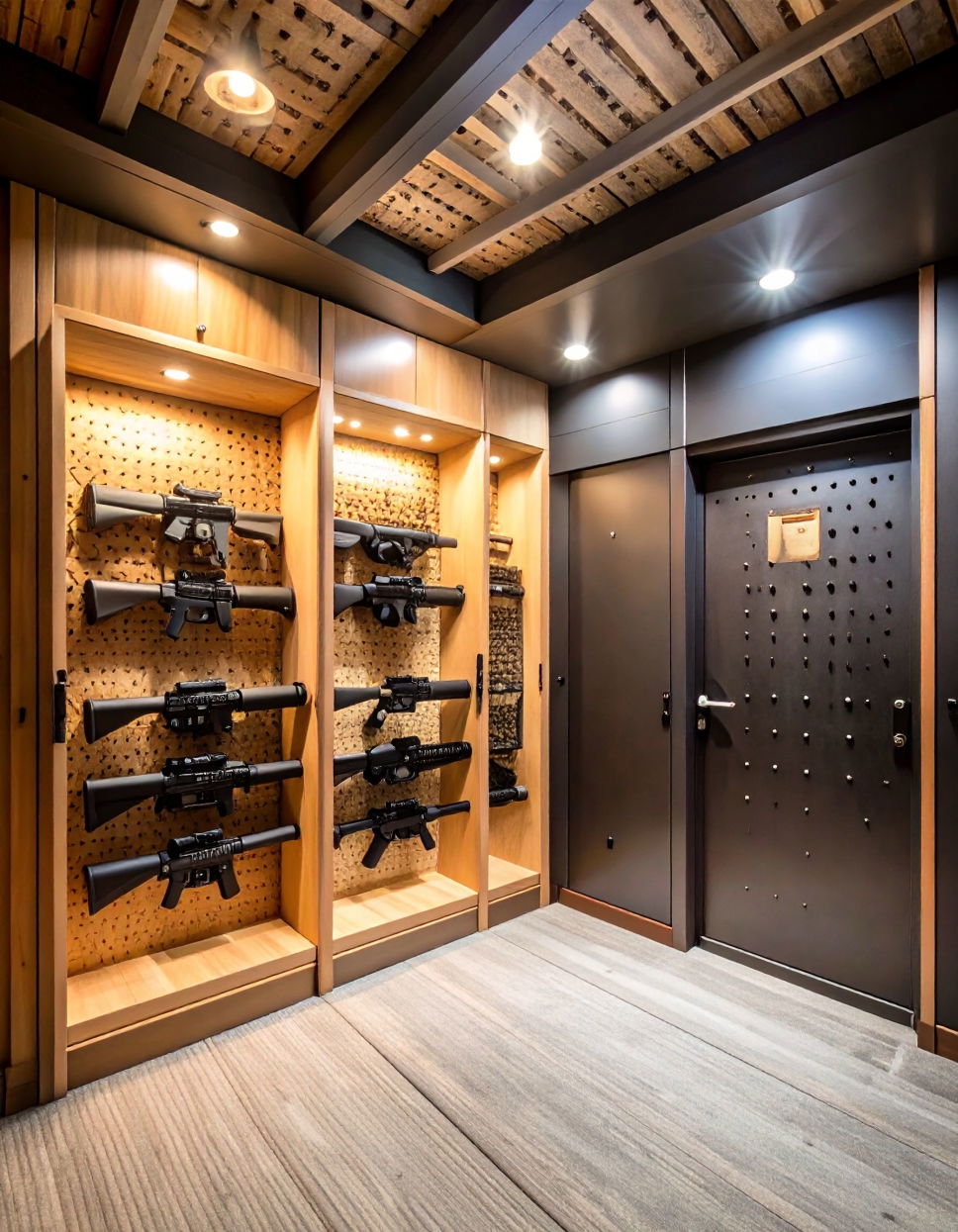

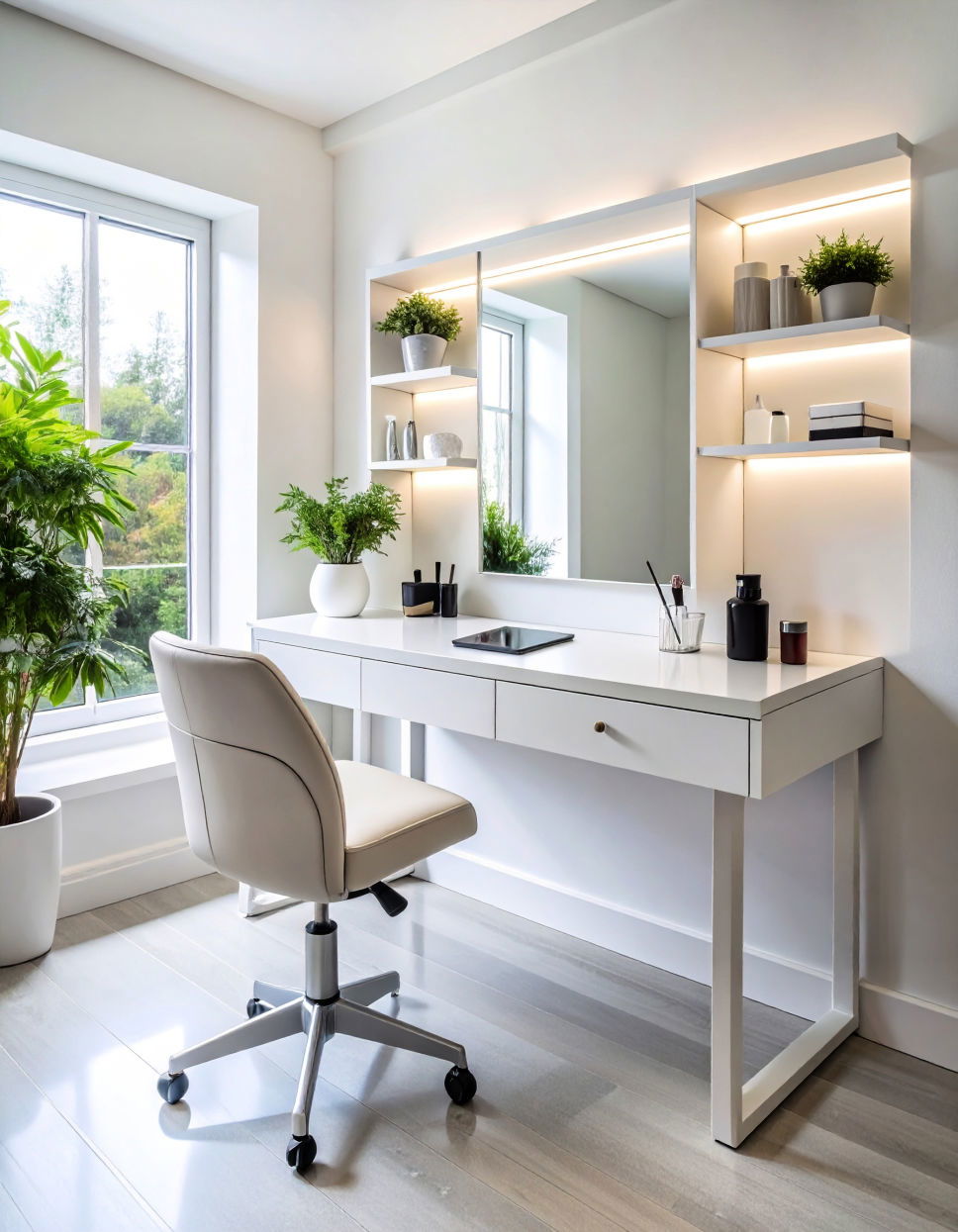

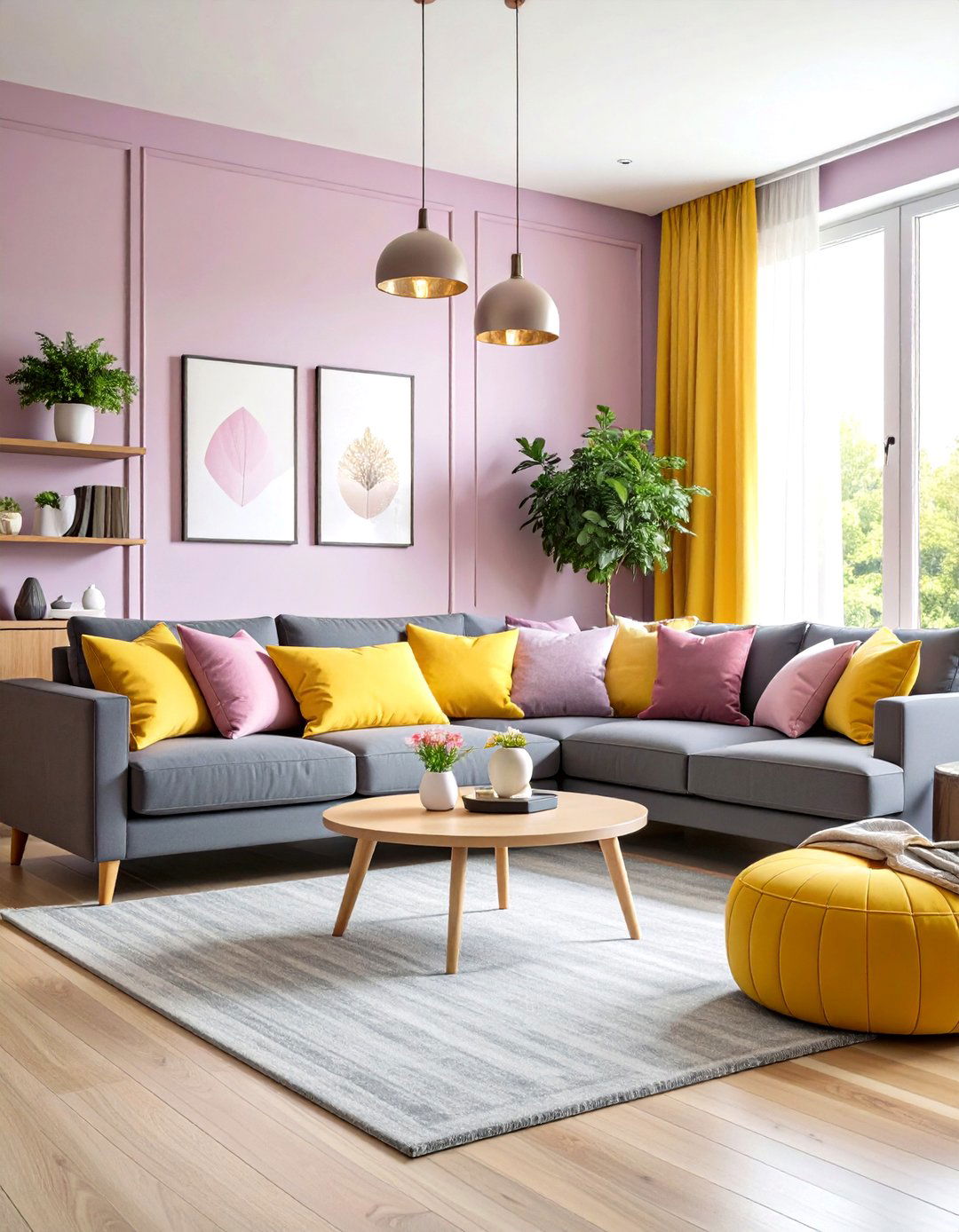
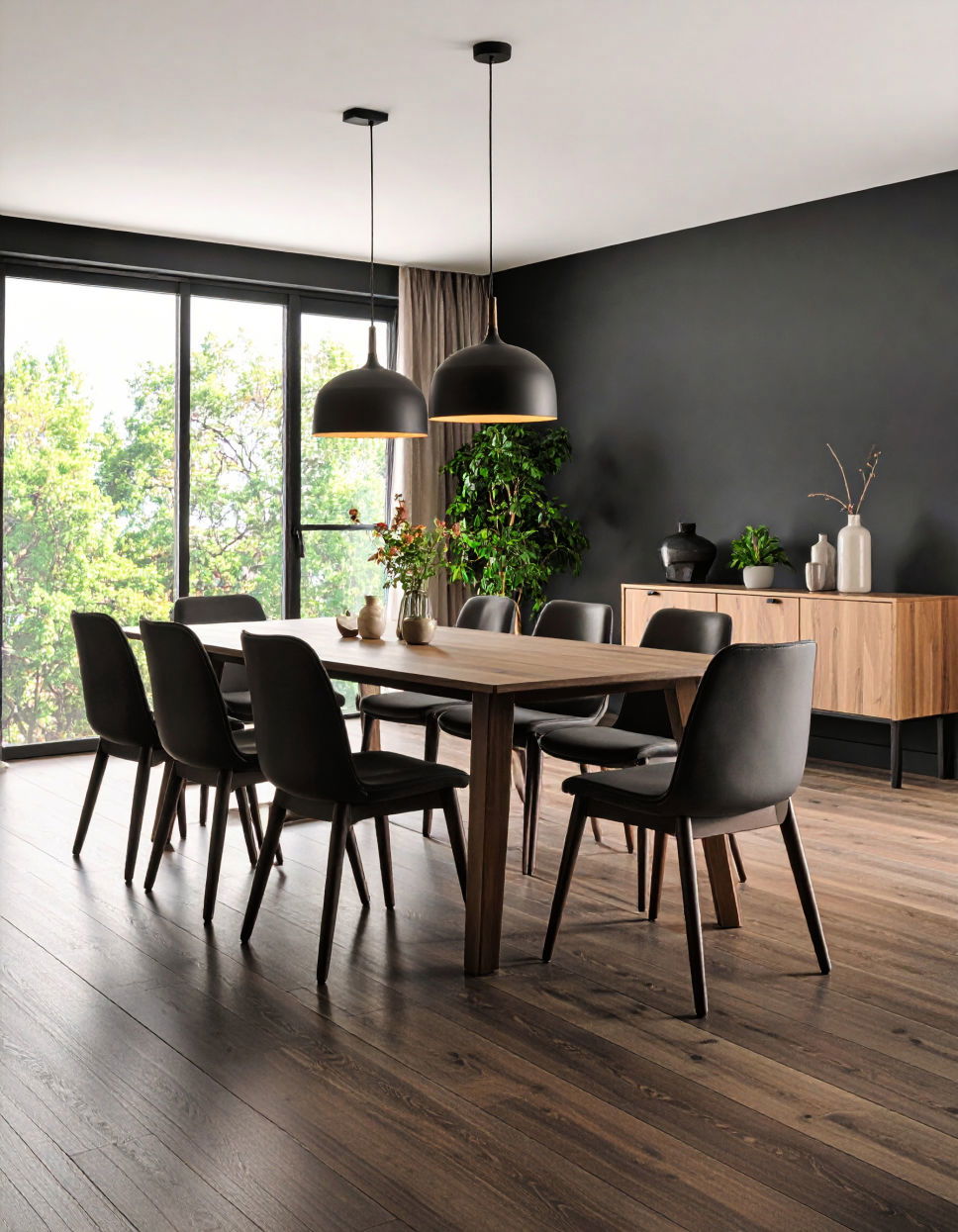
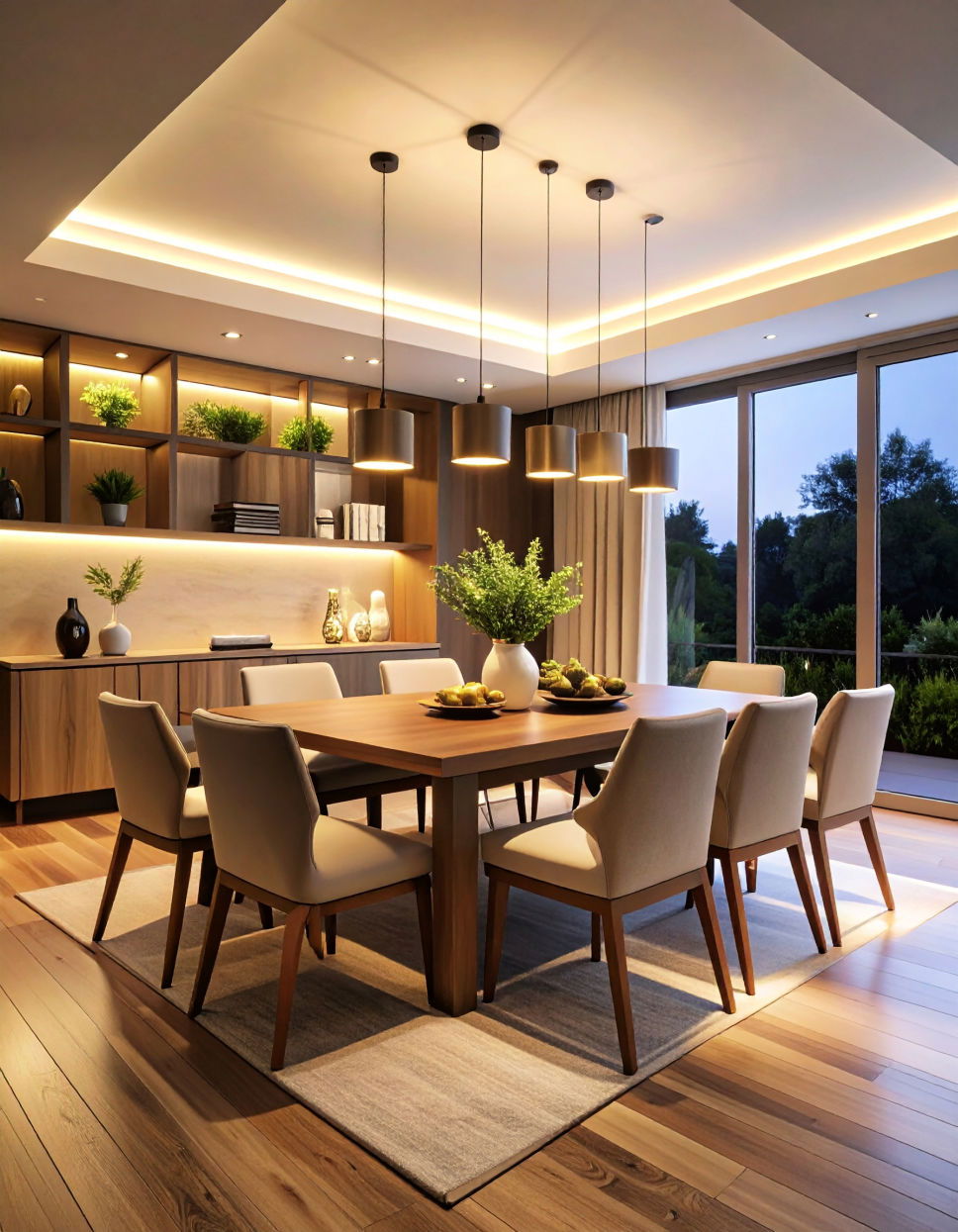
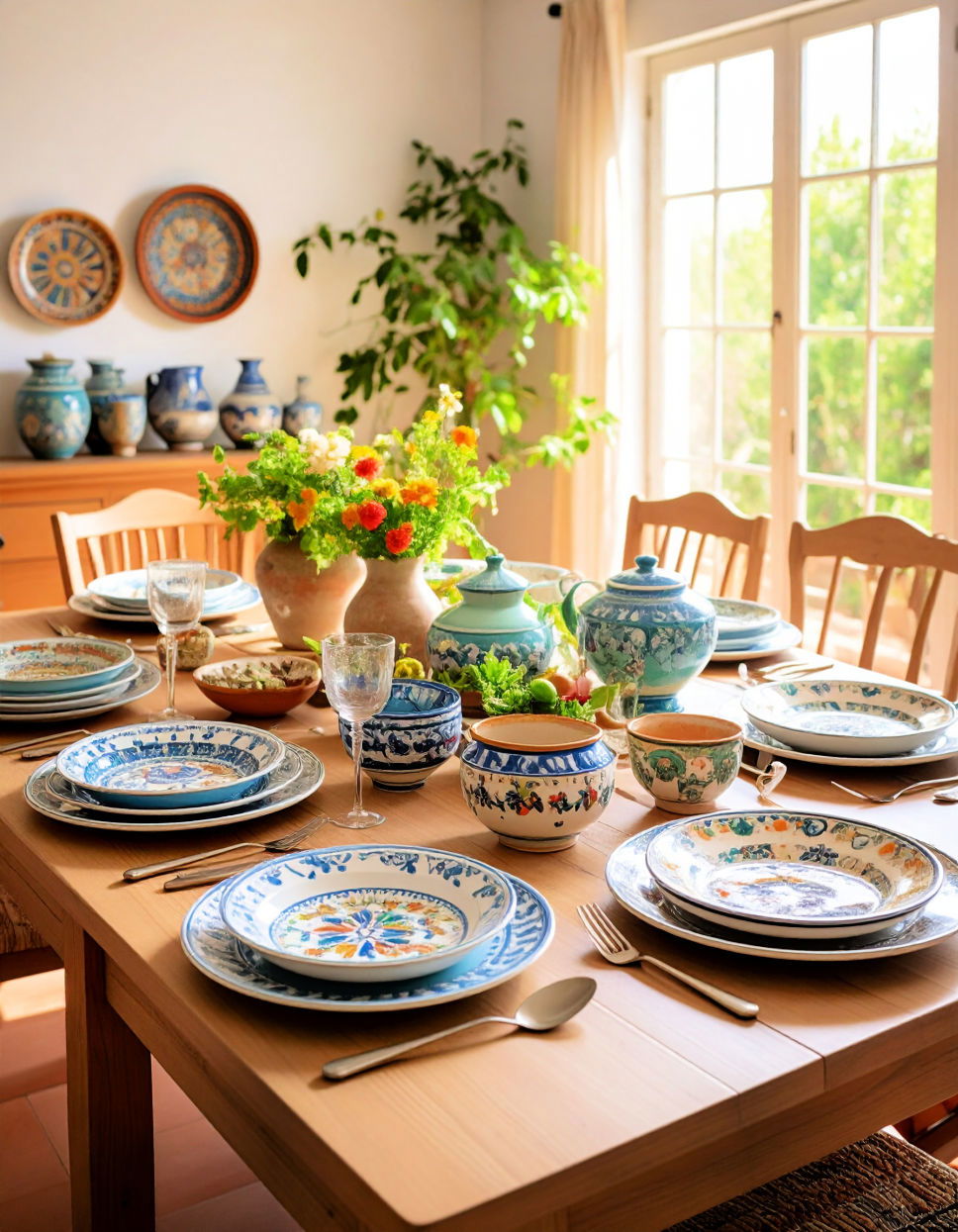

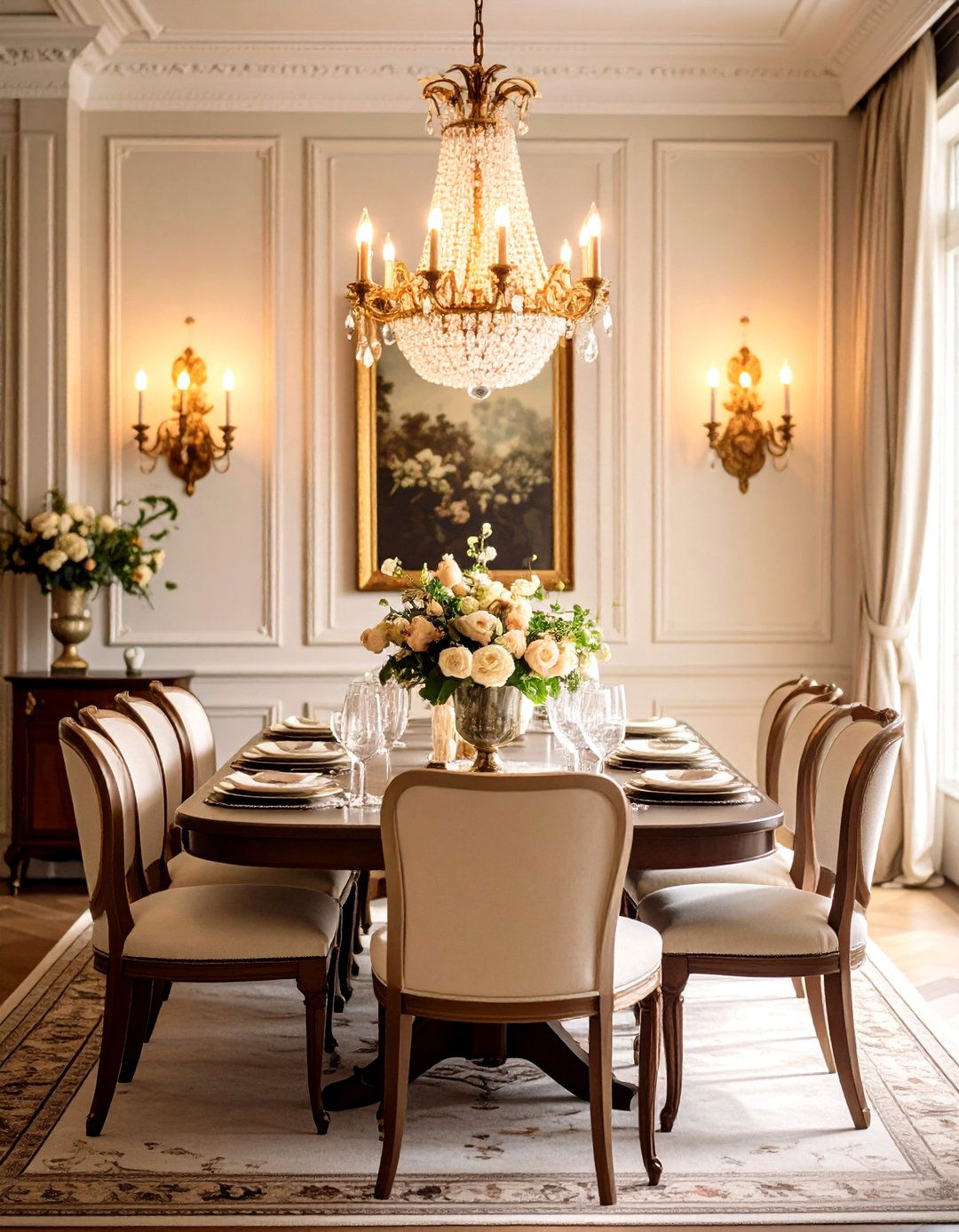
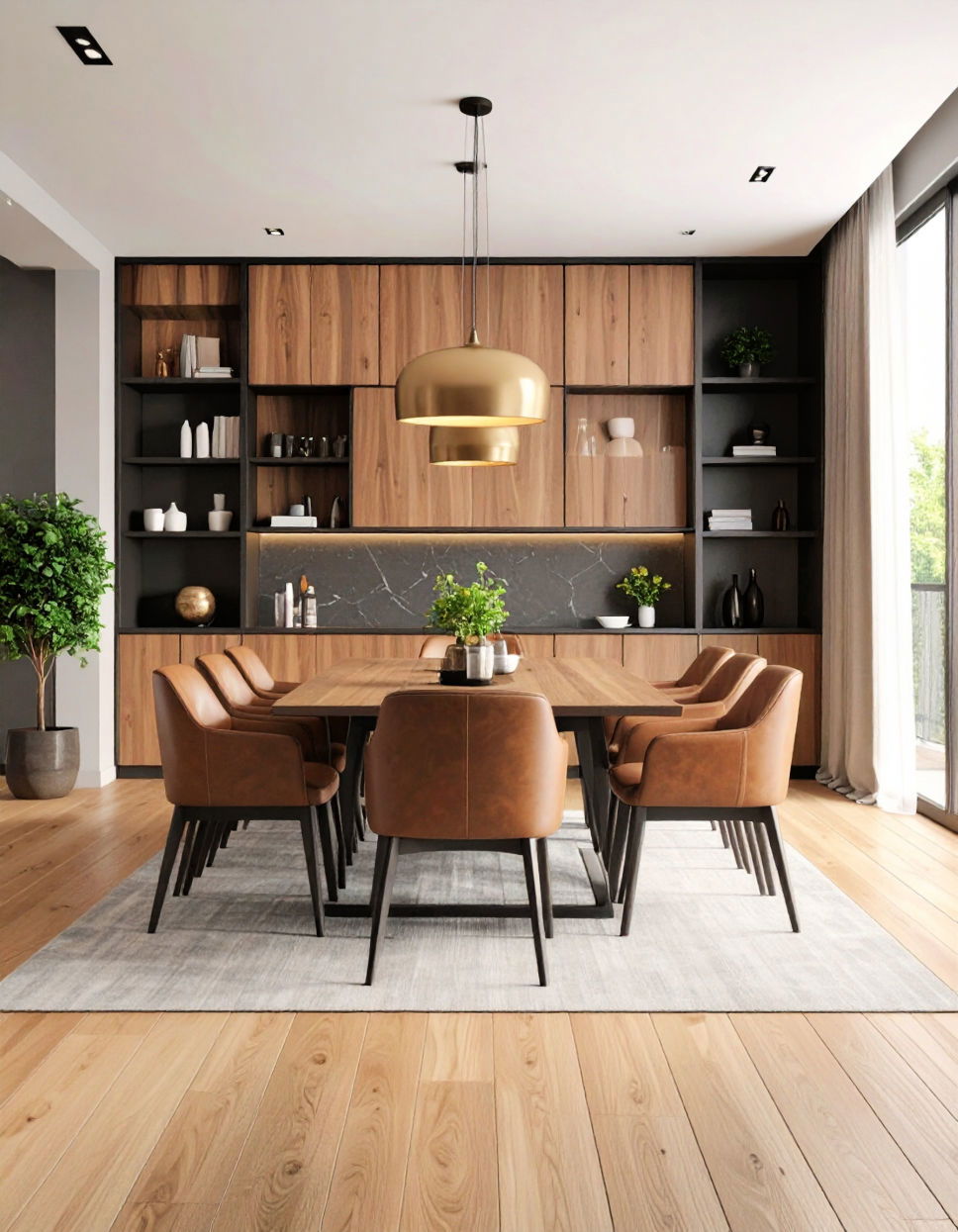

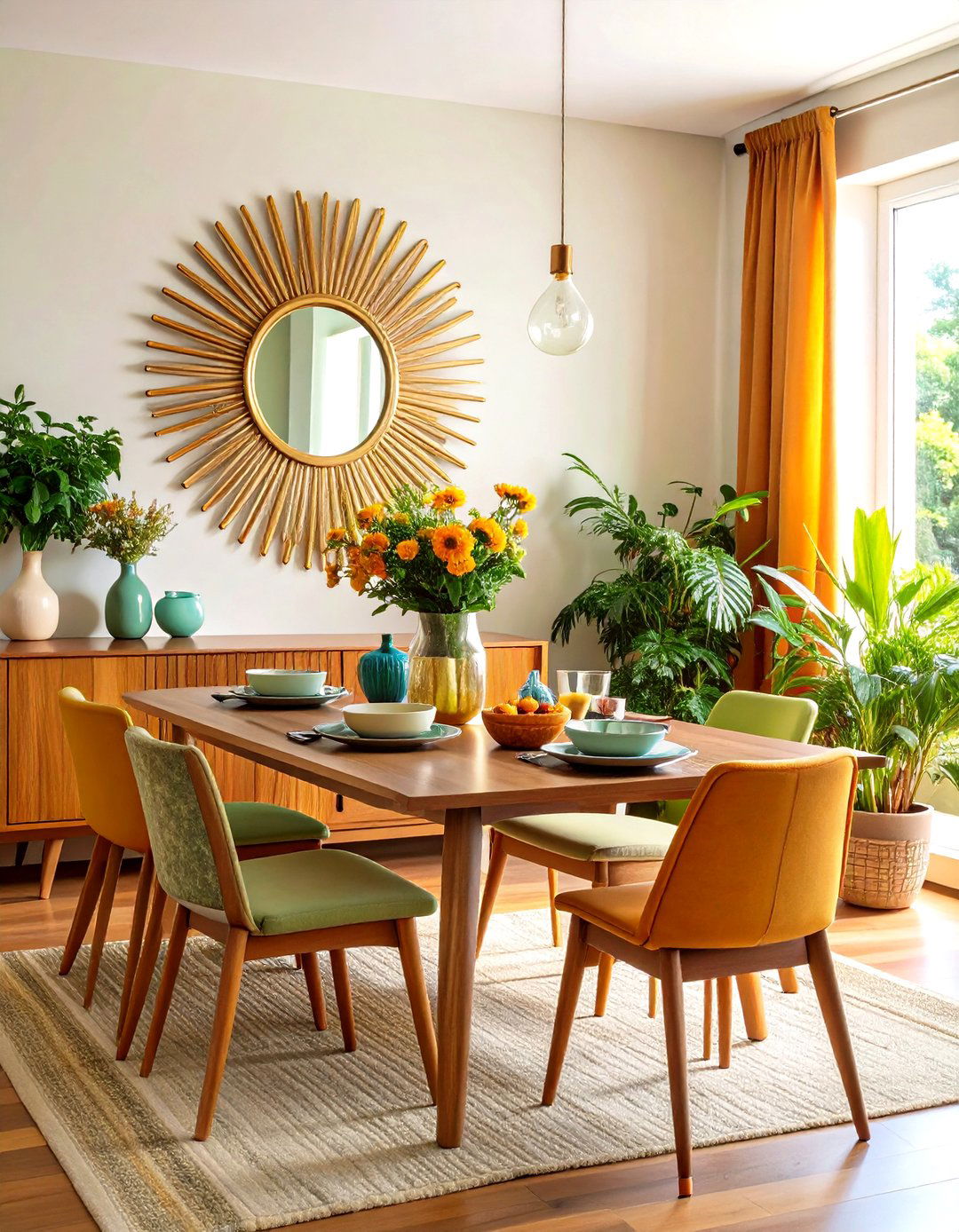
Leave a Reply